Ngritoo presents a rich exhibition at Galerie Garance for his first time in France. Present at the opening on September 6th, he will share his experience as a black person in a society where the word discrimination sadly does not belong to the past.
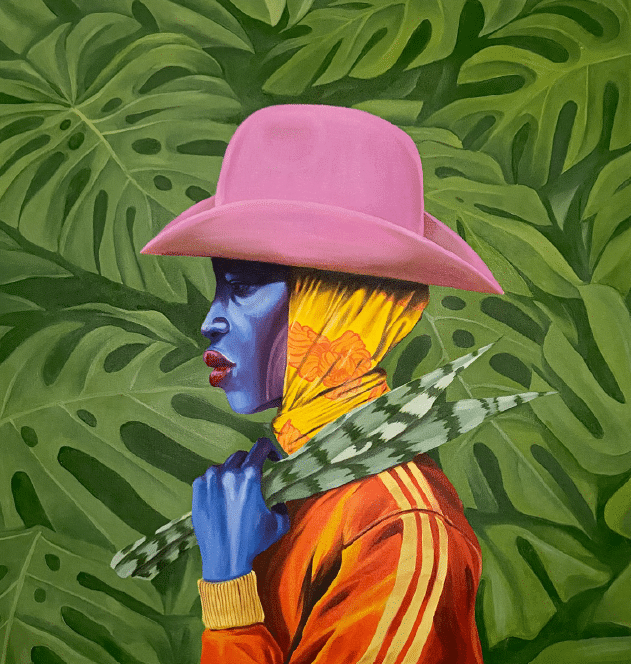
Our paths are filled with choices, experiences, and learnings that shape us as individuals and influence our perception of the world around us. In the exhibition "Mes Voies," the artist Negritoo presents his perceptions of the paths he has traveled so far, showing the public scenes of a daily life that often go unnoticed but are always present in the life of a Black person.
Negritoo's works aim to capture imaginary situations within a real context of lived and perceived experiences. At times, these works challenge and inspire questions or simply contemplate emotions, connecting the artist with his Afro-Brazilian ancestry and identity, bringing a sense of belonging and representation.

“Towards there, but very far down, it is a place. There's a crossroads. Roads go to Veredas Tortas – dead paths. I said, you didn't listen. Don't even mention that name again, no. Place no where. Places like this are simple – they give no warning”
Guimarães Rosa, “Grande Sertão: Veredas
When writing about artistic creation, we have to take a risk. Only in this way can we be close to the living experience of his gesture, close to the artist's daily life in order to connect us to the navel of his daydreams, where his most intimate desires, the images of his most sincere destiny, are born. Only in this way can we, without embellishment or secondary gains, expose some conscious and unconscious intentions that made Luis Alexandre Lobot get out of bed every day to produce something relevant and take the risk of exposing himself through his paintings.
From here I can say that Lobot in “YEARS PER SECOND, HOURS PER MONTHS, EVERY DAY”, does not think as he did before. I would even venture to say that he no longer works conventionally, that is, as an artist who needs a subject to paint. His new paintings, inserted into his daily life, are the result of the existential journey of a full-time artist, where painting is part of his muscles and psychological apparatus, this being his way of thinking, eating, drinking, imagining and telling. us a story.
Lobot creates images like Guimarães Rosa did with words when he wrote the country saga of the bandit Riobaldo Tatarana, our Brazilian Ulisses. The story of this time, hours on end, has the twelve labors of Hercules in conversation with the twelve years of the A7MA gallery.
A character, an enigmatic figure always present in Lobot's paintings and who has had several names, gained more corporeality and impersonality, taking the foreground of the canvas, without a face, lending us his face. Like a “semionaut”, a semiotics astronaut who navigates the symbolic universe, proposing mythological ties, making and undoing knots, uniting and disuniting different cultures, he invites us to imprint the face of our stories on him.
Without beating around the bush, Lobot suggests a decolonial revision of Greek myths, to cite one example, which are devoured by a northeastern rusticity, by the concretism and anthropophagic cruelty of an interiorized Brazil. Ocher and brown tones bring us to earth in the sense of a place that is both subjective, intimate and dreamy, as well as a historical land, inhabited by original and northeastern peoples. Here the Lobotian trickster who works tirelessly every day, always alongside the defeated, chewing ten myths per second, generates a fictional friction between the imaginary world that is in all of us and the old land that was here before the symbols and delusions humans.
Mythical surrealism, cangaço concretism, adobe techno-shamanism, anthropophagic metadata, abstract realism of ridges or the aesthetics of hunger and human blessings, are some terms that we daydream about under the new landscapes of Lobot: hours for months, earth, every day the sun is high, the synthetic materiality of a Brazilian painting.
We are captured by the serpent with a thousand heads, like a bullfighting philosopher taming the Hindu ox by the horn, barefoot, cracked foot, dirt floor and the Chinese dragon of endless travels, when we feel that the stories-stories of all human cultures are grafted onto ours, one by one, every day, hours by months, years by second, changing the course of our river. We see ourselves stunned like a rag of a Brazilian anti-hero. Herberto Helder, always a poet, every day, helps us understand the intention of the imaginary dragon that flies screaming above our heads. And he answers us in his Antropofagias, text I:
“We want to suggest things like 'image of breathing'/ 'image of digestion'/ 'image of dilation'/ 'image of movement' (…) we don't try to create pumpkins with the word 'pumpkins' (…) in the center/ we sneak in plans that cause occupations ('de-tune' opens the way for old explanations 'discourses of speeches of speeches' etc.) / let us fix this idea of 'plans'/ we can admit them as 'a kind of houses'/ or' a kind of fields'/ and then evident to be inhabited by worn paths”
Oh, okay, okay! The Lobot insists on blowing the animated fire of landscapes full of life-language. A daily and endless symbolic elegy of cataloging things, people and facts, dignifying them as someone who does nothing more and nothing less than live painting, scratching and taking risks in the risky way that is being an artist and having a structured life in arid, mobile and sandy terrain of Brazilian art. Nonada!, as Tatarana says, “living is very dangerous”
Text by Bruno Pastore, Lobotian philosopher, writer and poet.
🗓️March 1st to 15th
📲 Tajan Auction with Drouot Paris
We have the pleasure to be part of the upcoming charitable auction with Tajan Auction to support the action of the non-profit organization Cami Sport & Cancer.
Each of our selected artists will donate part of their sales to this beautiful association which developed sport activities to accompany those fighting against cancer - believing sport contributes to lower the undesirable side effects of the treatments and to improve the chances of remission.
When : January 6th to 7th
Where : Gallery Artivistas - 35 rue Blanche 75009 Paris
After almost two years exhibiting in major museums in Brazil, top galleries in NYC and Miami - Enivo arrives in Paris for an exceptional showcase to present his rich universe.
PAULO ITO’s new series of cartoons was exhibited at the Museu do Trabalho from September 27th to October 23rd – offering a mix of formats from illustrations to large paintings, he also used the walls of the museum as his own canvas.
Paulo Ito has been a reference across South America in his way of dealing with relevant topics affecting the current society, especially of Brazil where Allan Sieber defines him as “a rare chronicler of urban life“.
Street art is for him a medium to connect everyone, no matter their social or cultural backgrounds, to his messages, with always the same purpose – highlighting with humor and sarcasm what’s wrong in the world.
Painting the city’s walls to celebrate the health professionals in the middle of the pandemic, or to warn about the excess of alcohol’ dangers or to denounce the budget invested in the 2014’ FIFA World Cup while children are starving across the country – Paulo Ito could not hide even if he had wished to as his style is unique and easily recognizable – while people dream about superheroes in movie theaters, Paulo Ito is one in real life, roaming the streets to inspire passerby for a society with more common sense, goodwill, equality and solidarity.
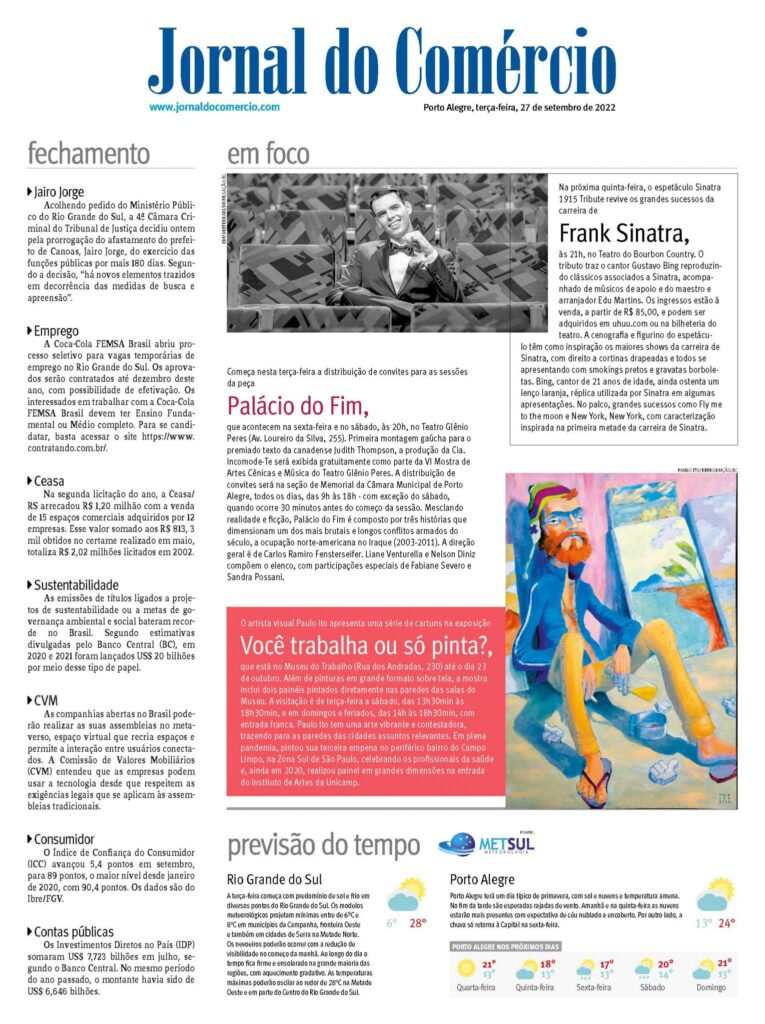

ZIV Gallery, Sao Paulo
The presence of women in places where they did not belong a few years ago can be transformative and revolutionary. Anyone who knows a little about the world of surfing knows how sexist and oppressive this environment can be for women wanting to start the sport from scratch.
FERNANDA YAMAMOTO was inspired by Sapê Beach in Ubatuba, characterized by the female solidarity and network to train women of all ages and surfing levels around the spot. Focusing on their common love for sport and honoring a mutual respect for the sea and its ecosystem.
Surfing there every week, FERNANDA YAMAMOTO never witnessed a conflict – on the contrary she noted women celebrating each other’s waves, exchanging tips, and encouraging one another. No feeling of competition, Sapê is a place of celebration and share.
The Sapê series is inspired by this experience of surfing among women while capturing their captivating and individual stories. FERNANDA YAMAMOTO depicts the way sport can gather a rich pallet of personalities, differences and aspirations around a common passion and common love for the nature.

We had crossed the month of September on our agenda to finally make our first public appearance and introduce to the public a pallet of our artists from the other side of the Atlantic.
Coming back from Brazil in August with 30 paintings enrolled in a PVC tube and ready to be framed at Marin Beaux-Arts – our initial bet to exhibit exclusive creations was successful – not without stress but certainly with passion and excitement.
On September 14th, the Hôtel Drouot opened its doors for the District13 International Art Fair to get started along with the 36 galleries which had joined for the occasion. NAGA Collectivo was surely the most recent “newborn”, proud to contribute to the event with established galleries among which the Lavo/Matik, Urban Gallery, Galerie Mazel, Vangart and Bahia/Utopica.
At the stand 14B, next to Art’Murs and facing Albin Michel Editions, we were waiting for the visitors to discover our world and travel across Central & South America through the works of some of our artists:
For the occasion, SERGIOFREE had depicted a piece of the Beco do Batman in Sao Paulo on which ENIVO, PAULO ITO and KUEIO added their “street art” – instead of a picture, we chose to use painting to gather different styles on a single canvas.
ENIVO has been presenting in 2022 a series of three distinct exhibitions under the curatorship of the wise and visionary SIMON WATSON. In total more than 30 paintings narrating the deep connection between ENIVO and the people. Organized in three stories with a his solo show “AFETO” at the Museu de Arte Sacra in São Paulo, then his contribution to the collective exhibition “NALUTA NALATA” at the prestigious Museu Nacional da República in Brasília, and finally a solo show “BRAZA” at the Kates-Ferri Projects in New York City.
With 2022 coming to an end in a couple of months, we wished to share a rich retrospective of Enivo & Simon Watson’ fruitful collaboration.
AFETO – Museu de Arte Sacra de São Paulo
18.06.22 – 20.08.22
Curatorship of Simon Watson
Based on Enivo’s long-term relationship with the streets and its ecosystem – AFETO was inspired by Father Júlio Lancelotti, whom daily denunciation on social medias of the humanitarian crisis affected deeply Enivo. The series of 12 paintings aim to honor the anonymous humble people occupying and living on the sidewalks and shelters of São Paulo. To enrich his visuals, Enivo dug into the photographs of Daniel Kfouri, Lukas Juhler and Victor Angelo.
The exhibition invites the audience to discover the shocking and revolting reality of the people too many tend to ignore along their daily routine – whether a man obliged to eat garbage to survive, whether a family sleeping on the ground – while highliting their will to live – whether through jugglers on Rua Funchal, whether through Zé Cabrita (a deaf and mute political candidate) riding a decorated motorcycle in Grajaú’s streets.
Originally a successful and well-respected street artist, Enivo reminds that art is a powerful way to educate about the hard reality of megalopolis and a create way to empower those who are suffering and fighting to survive.
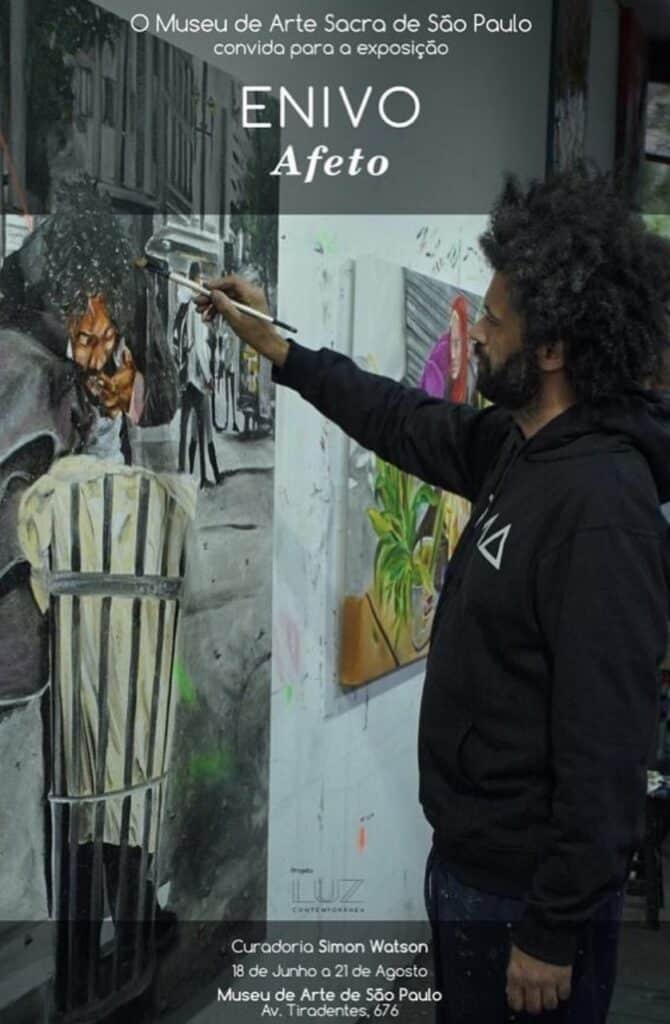
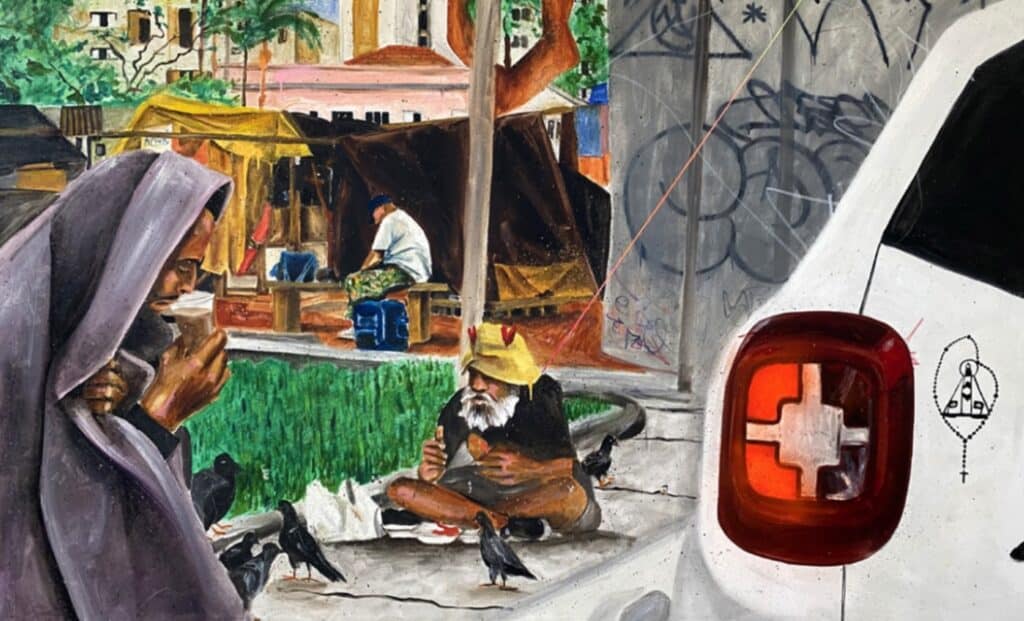
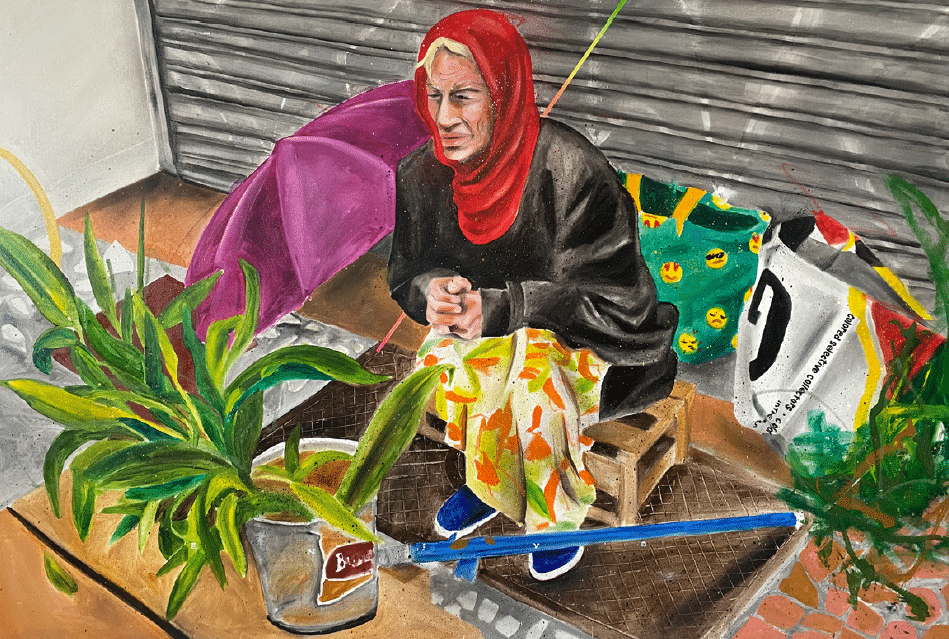
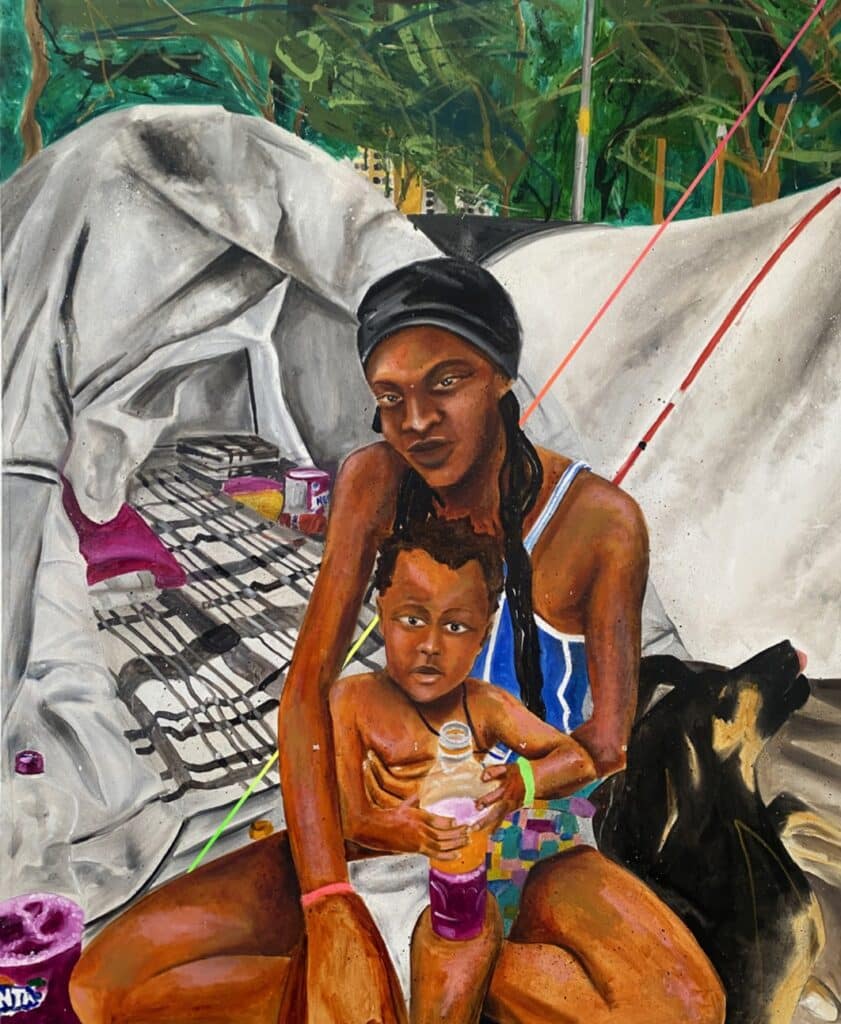
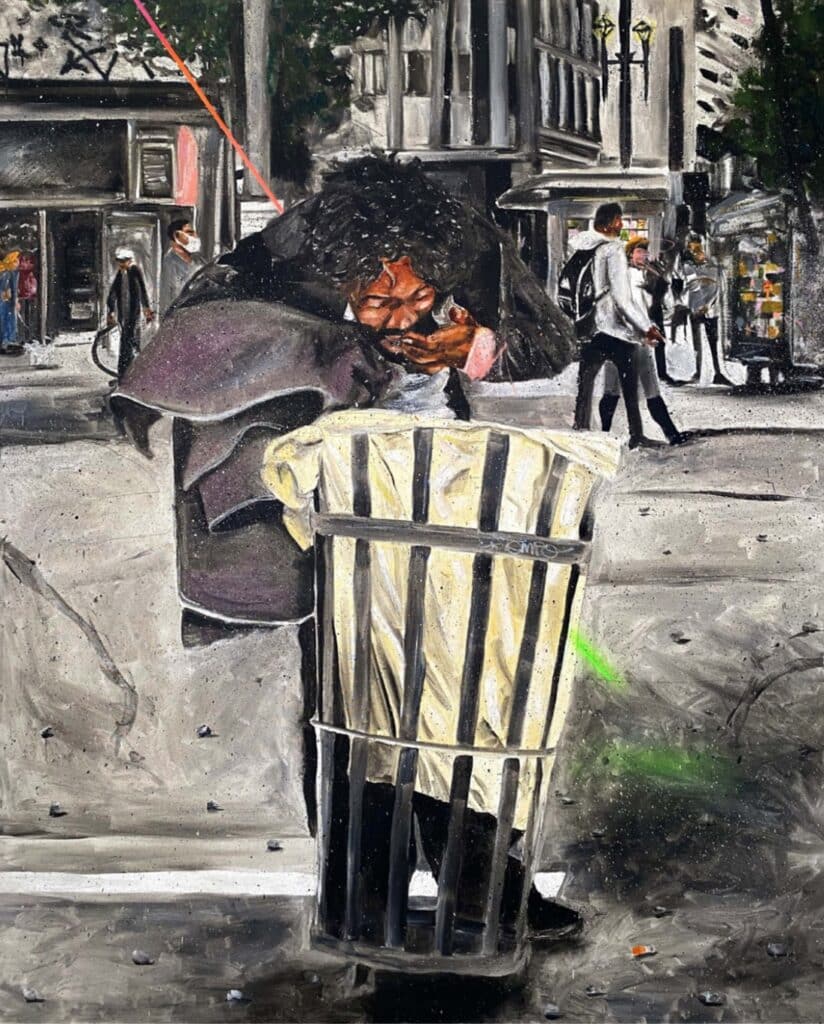
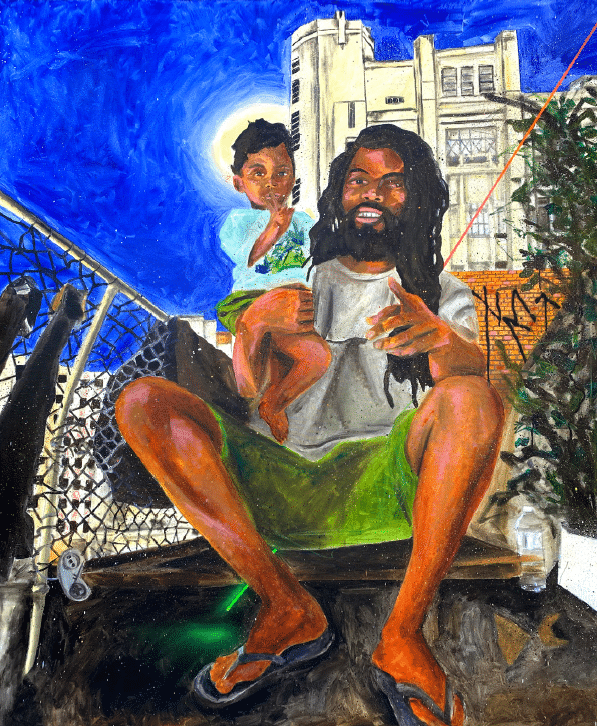
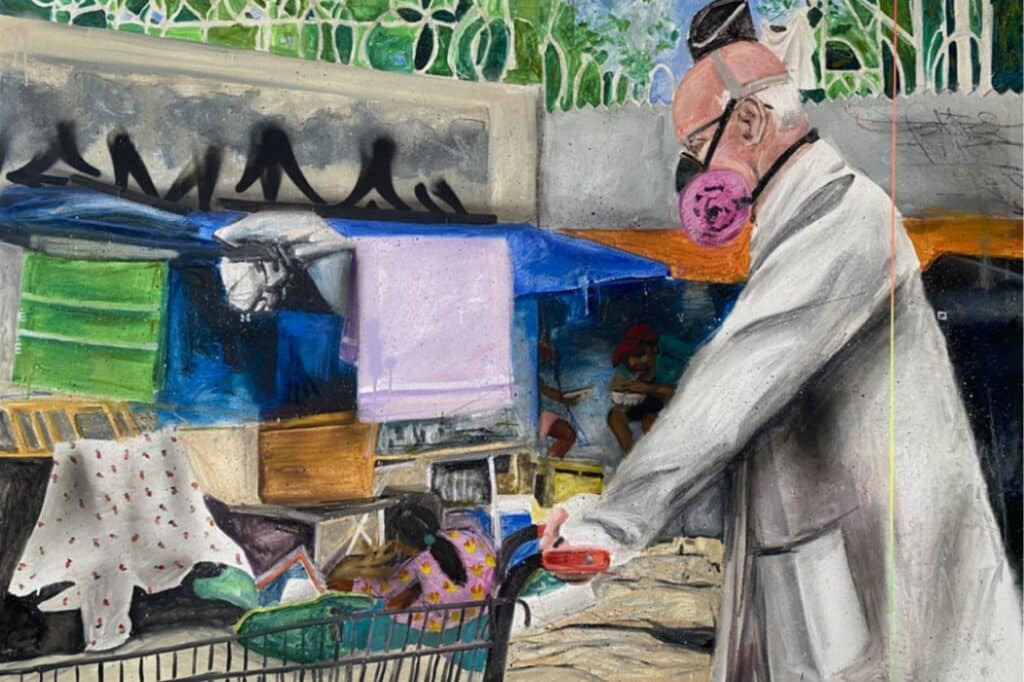
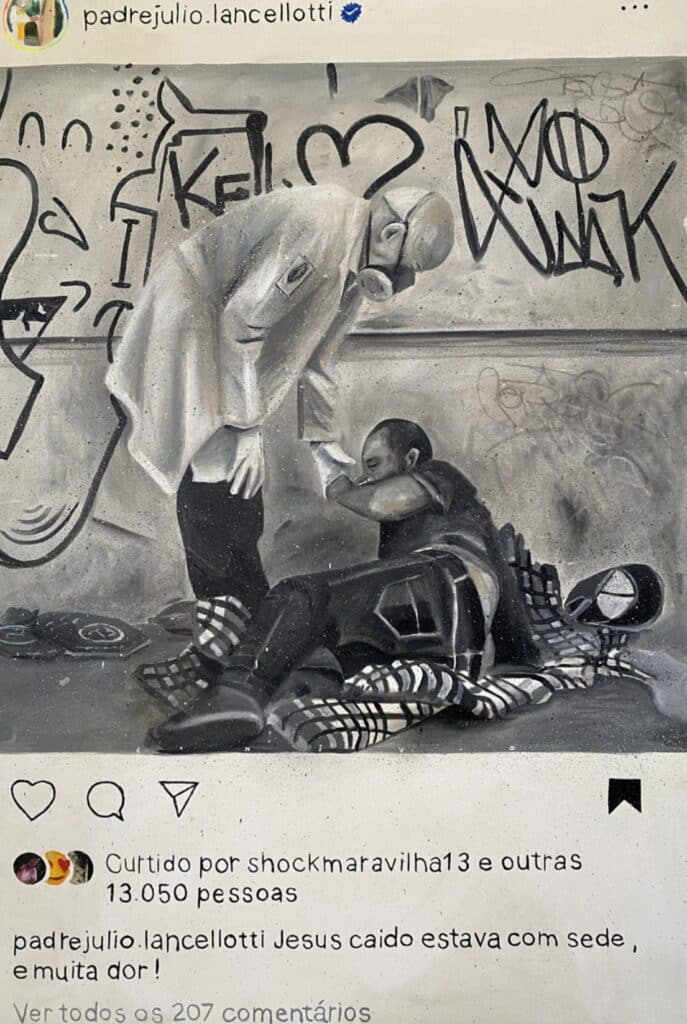
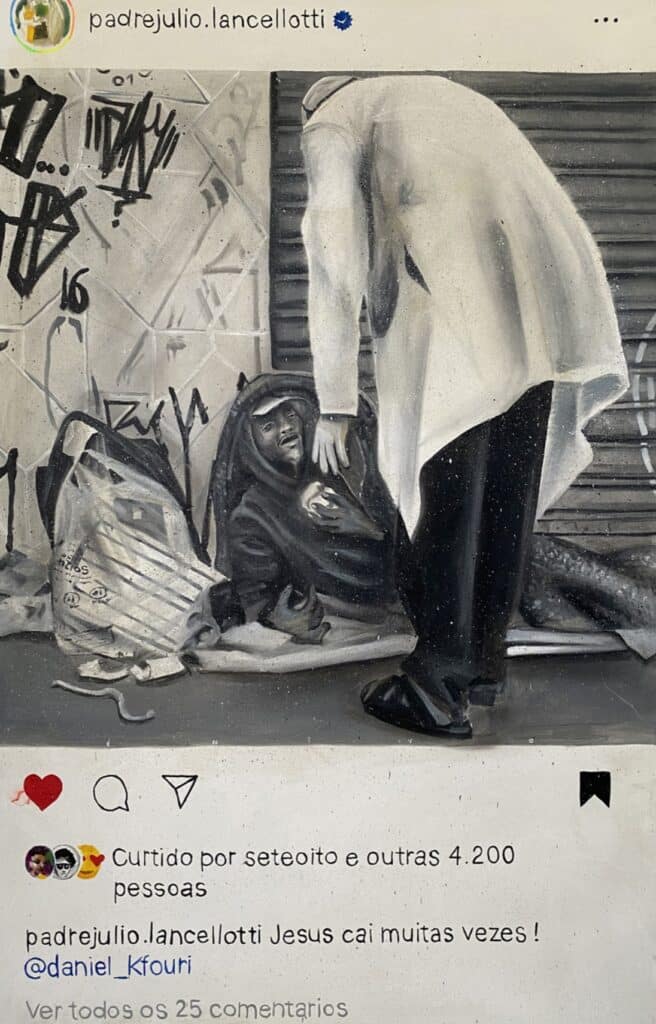

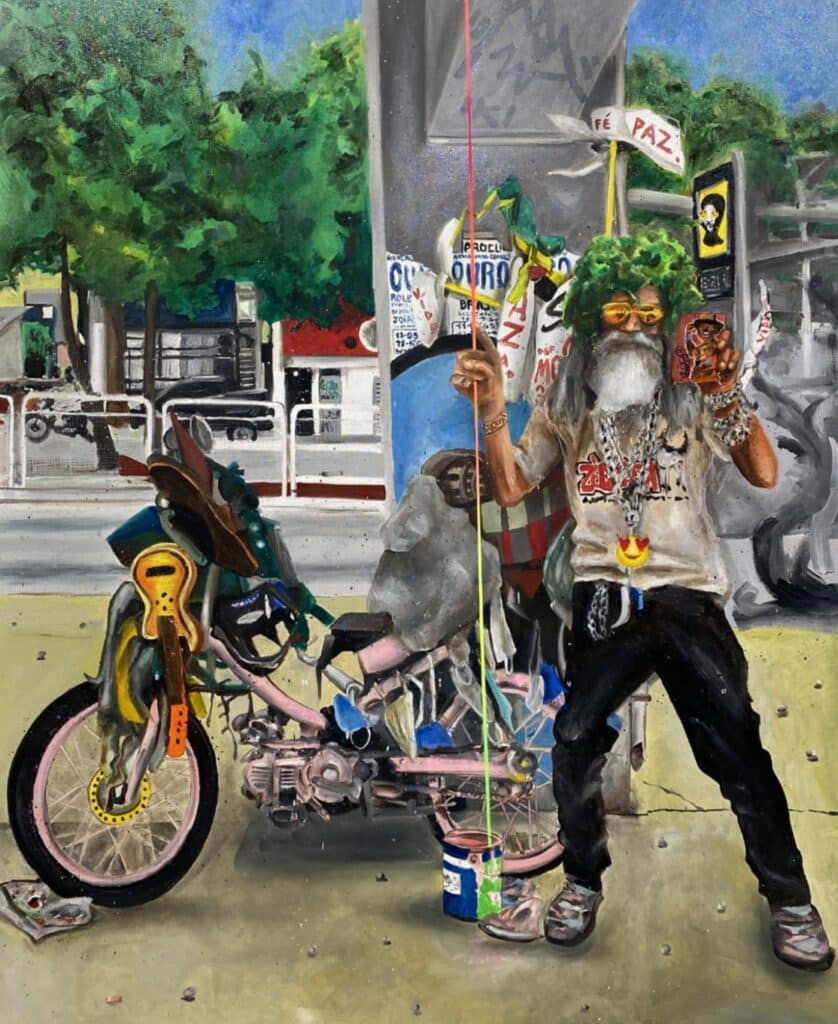
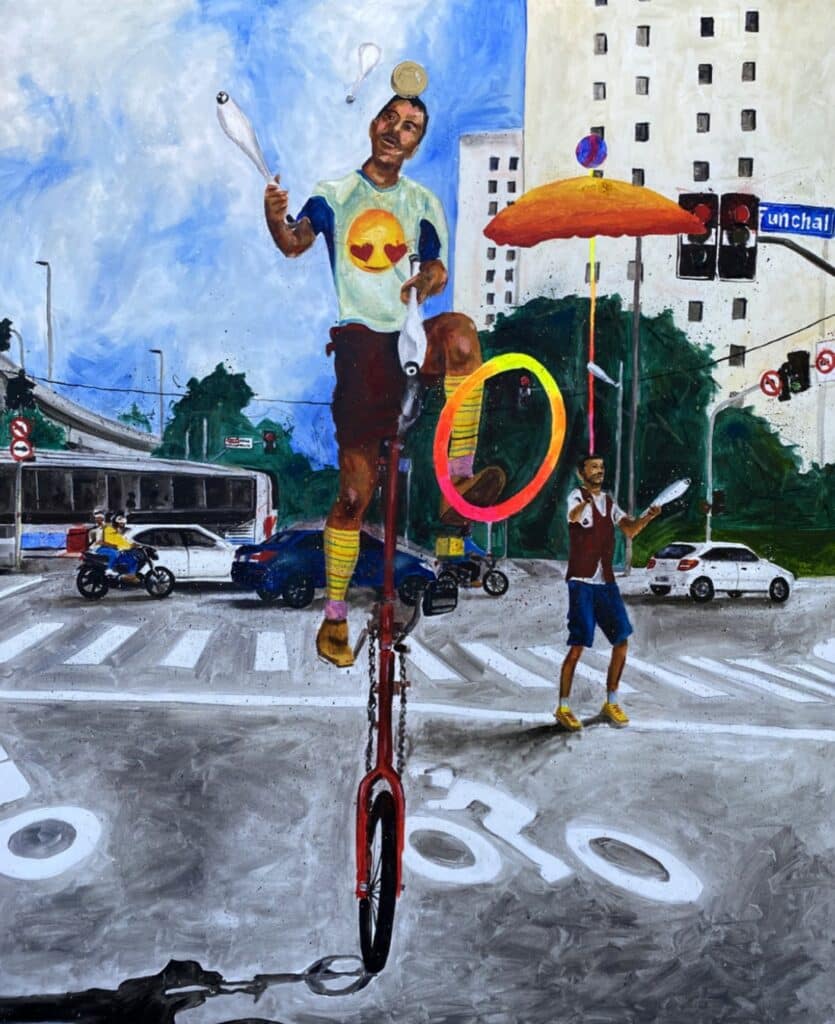
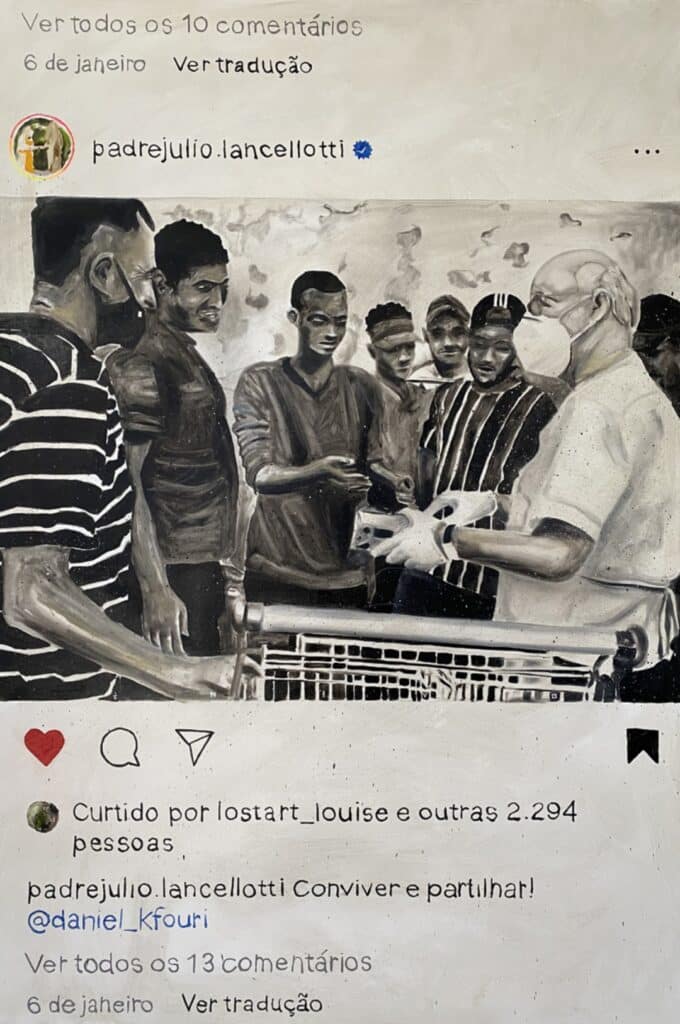
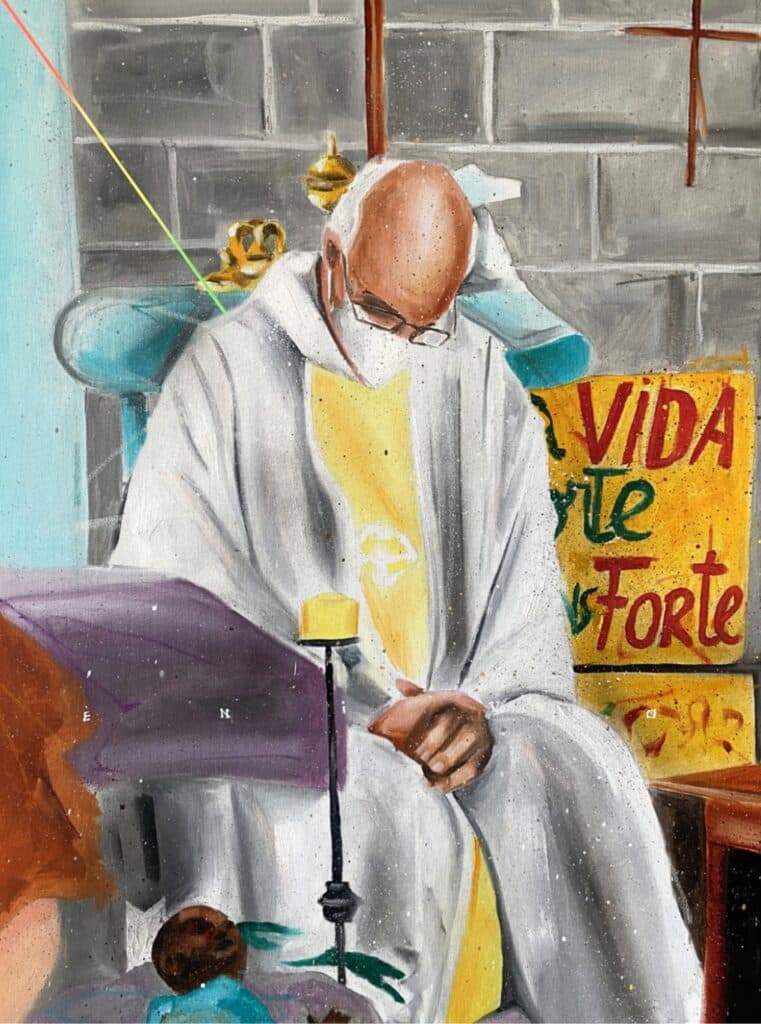

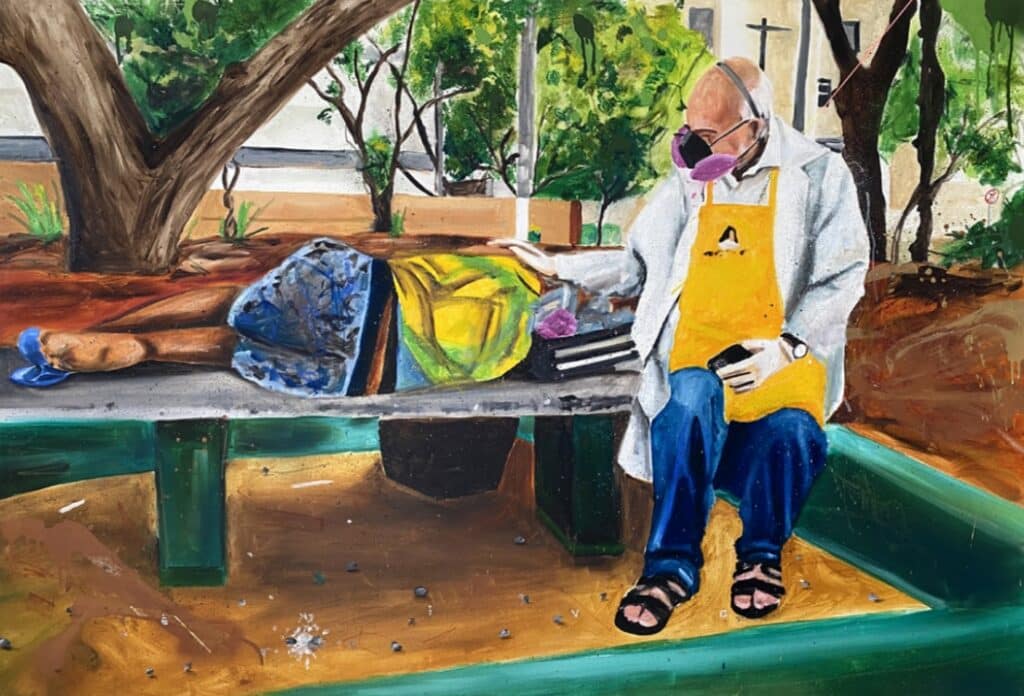
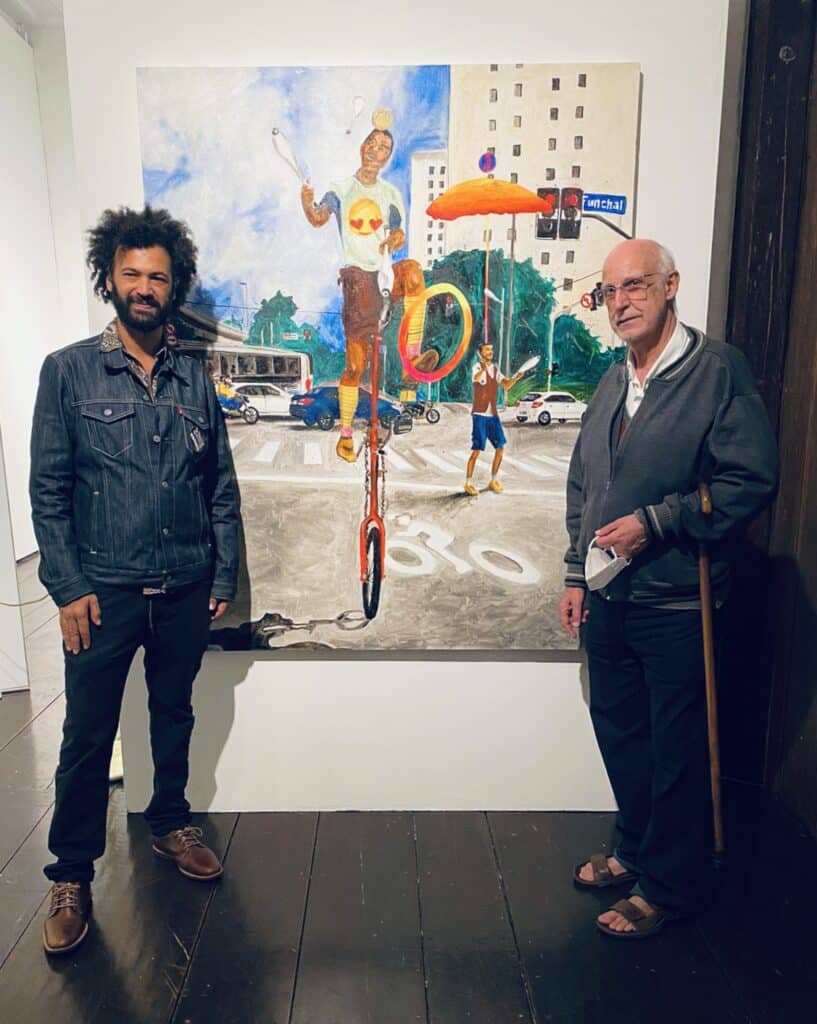
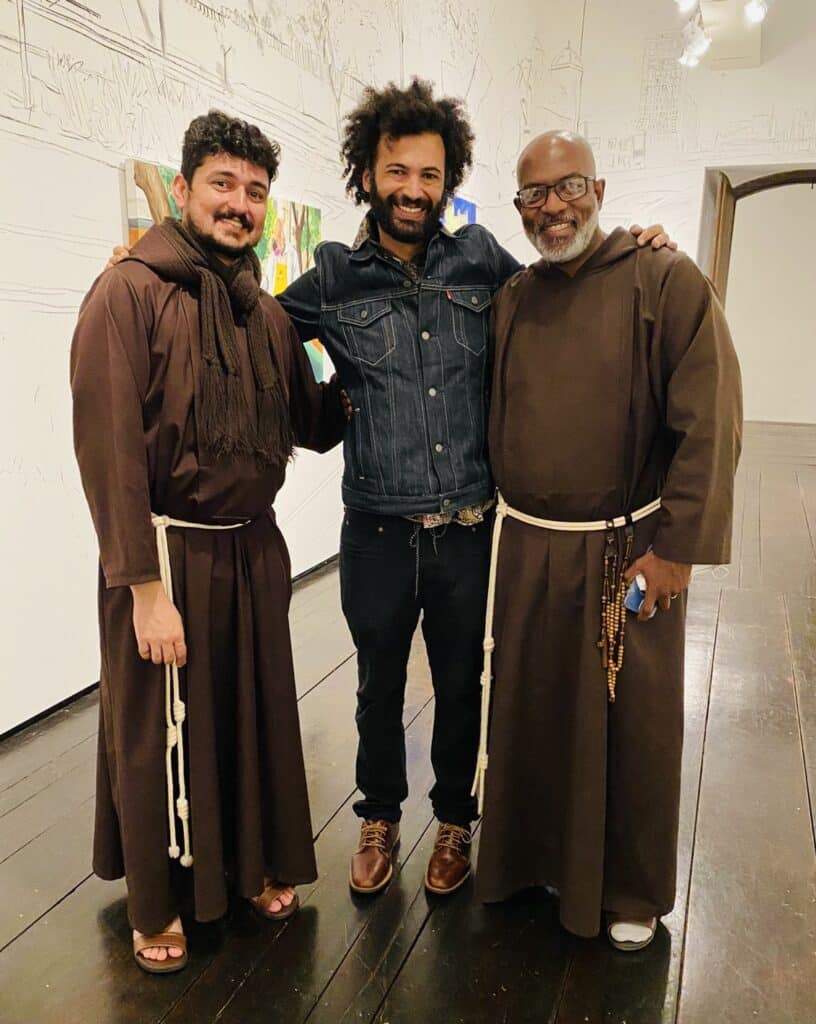
NALUTA/NALATA – Museu Nacional da República (MUN), Brasília
19.08.22 – 02.10.22
Curatorship of Simon Watson & Luan Cardoso
When walking into the MUN, impossible to miss the giant inflatable smiley – one of ENIVO’s trademarks – standing in the middle of the space as a connecting point beween the 16 artists curated by Simon Watson and Luan Cardoso.
Naluta/Nalata explores the spirit and dynamics of Brazil’s streets under the impulse of its new generation of artists – drawing attention to Brazil’s rich and vibrant urban culture. Graffiti & street artists largely contribute to the artistic landscape – using the walls as giant canvas to communicate directly with the population, no matter the social and cultural background.
Among Tinho, Diego Aliados, Mag Magrela, Mundano and even pixadores (cf. full list in images gallery), Enivo acquired the legitimacy to be a spokesman of the Brazilian street and urban culture to which he pays hommage with stories on canvas, and which he honors when regularly volunteering to bring colors through his spray in the favelas.


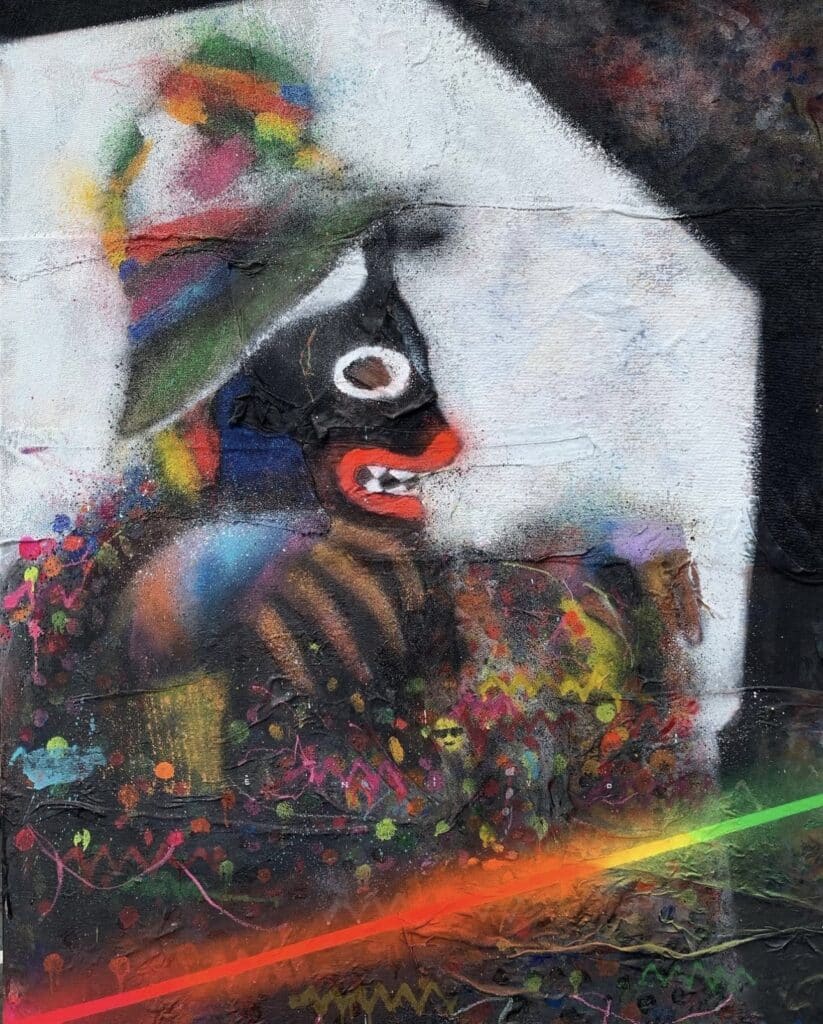
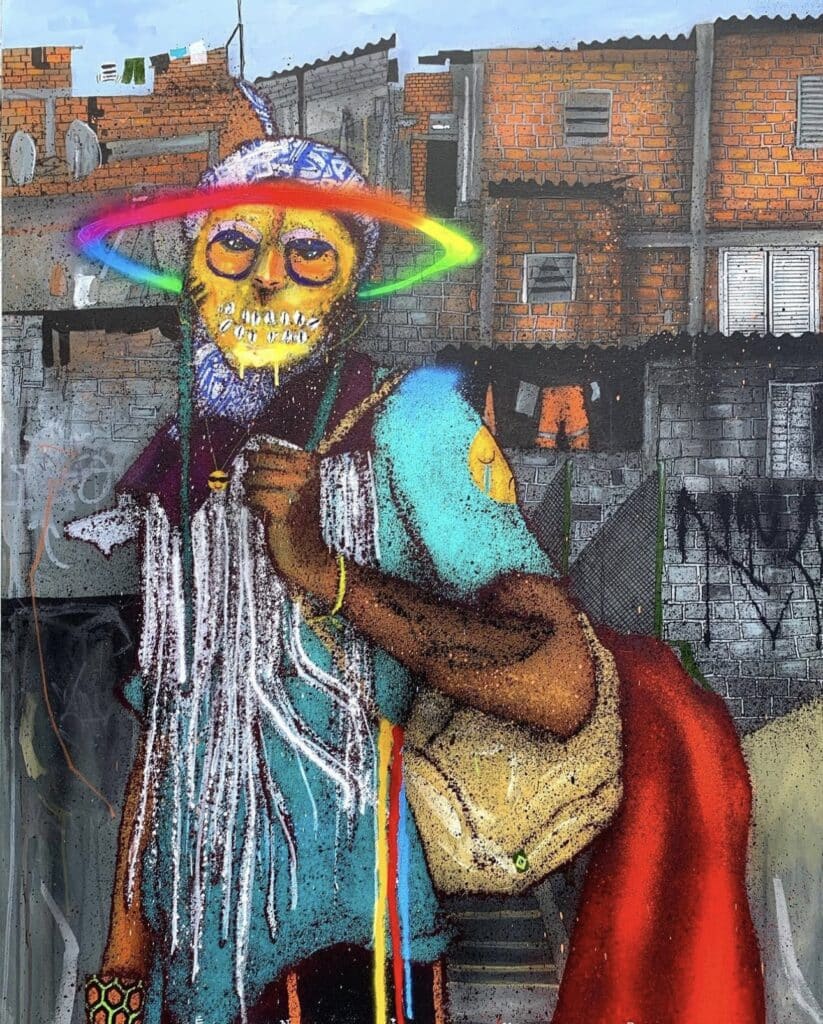

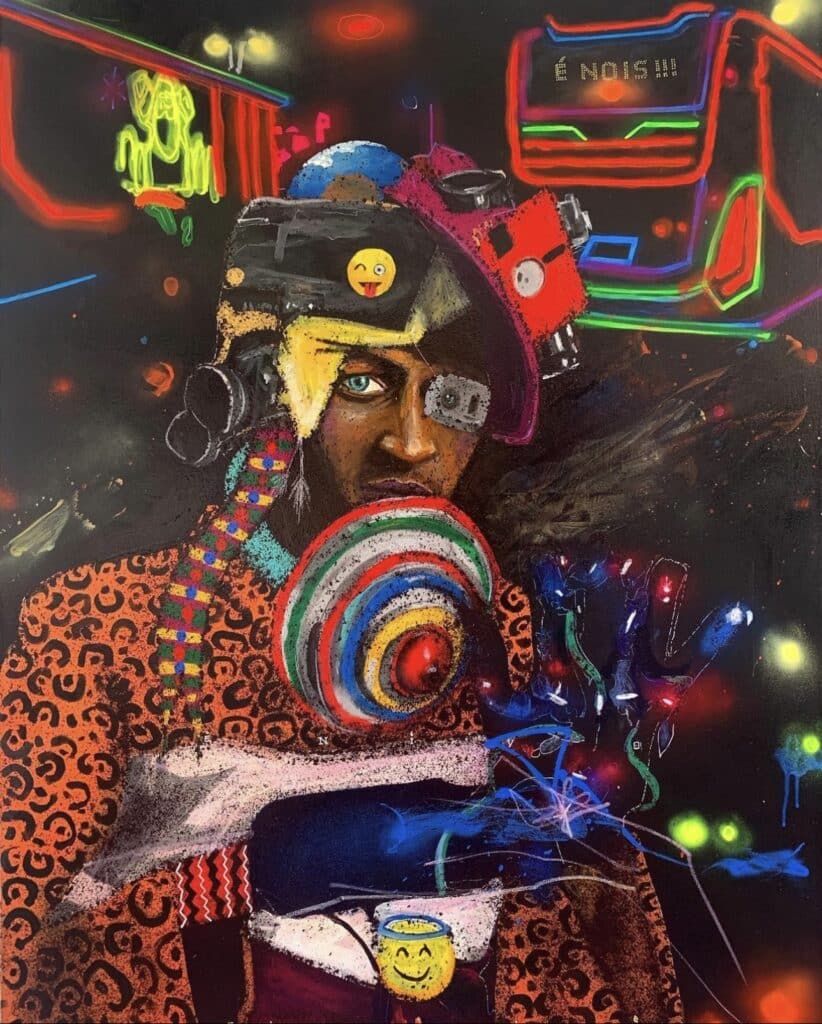
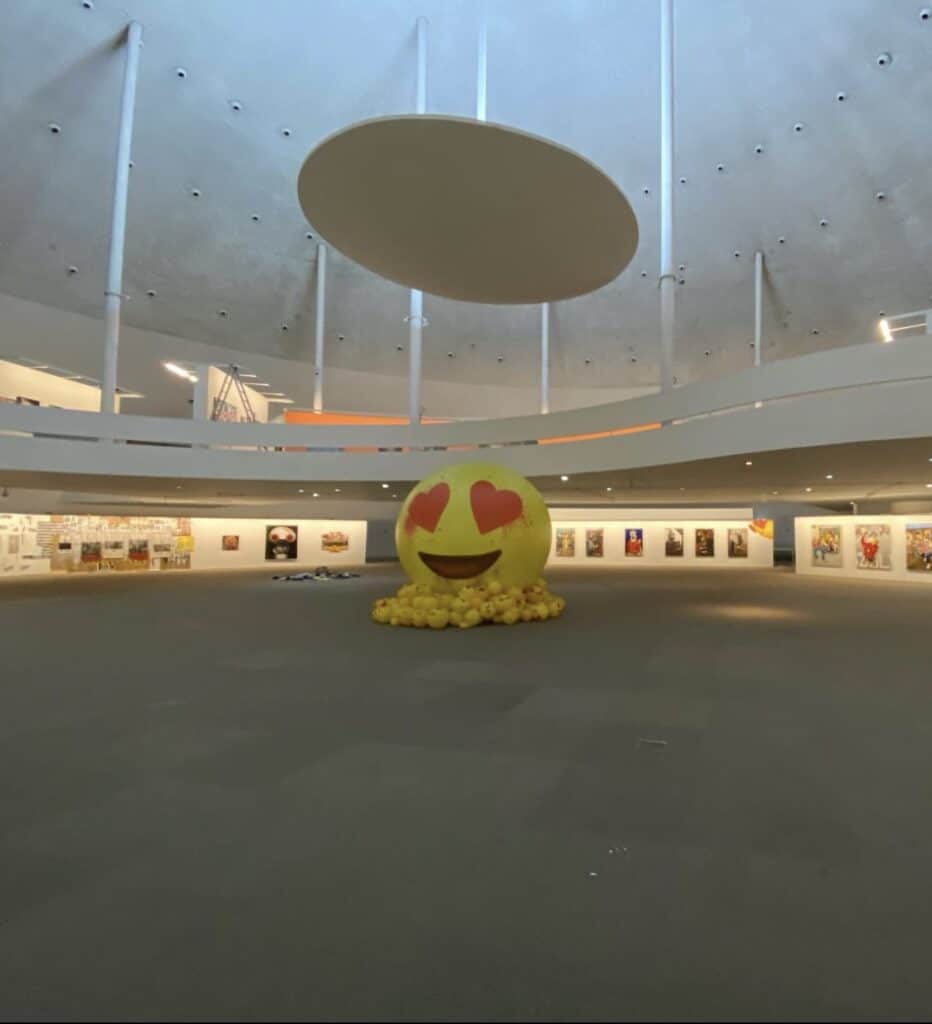
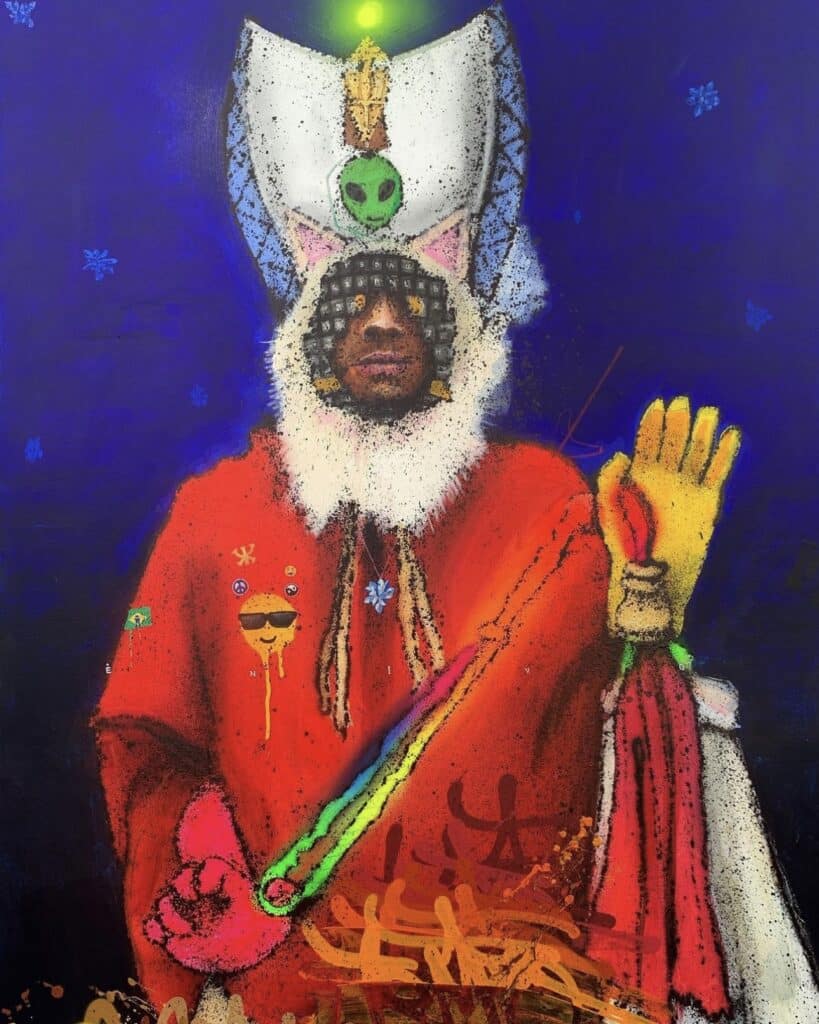

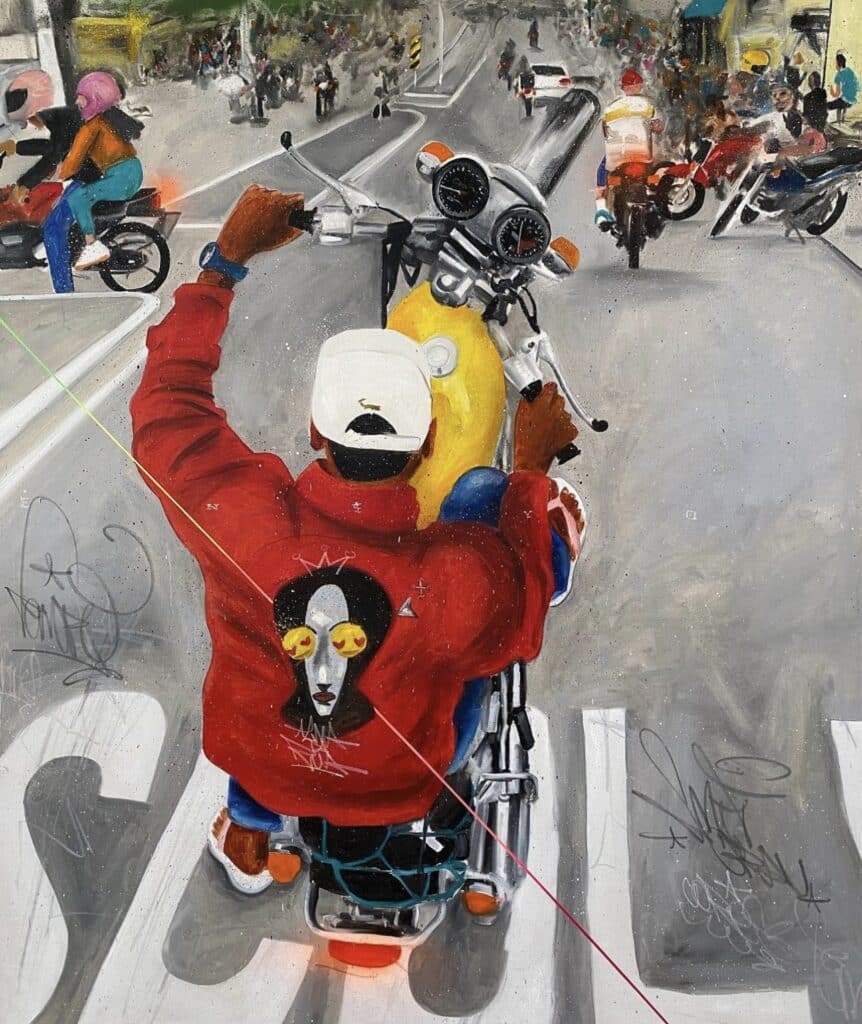
BRAZA – Kates-Ferri Projects, New York City
07.10.22 – 04.11.22
Curatorship of Simon Watson
Website / Instagram / Untitled Magazine
No better way than ending our tour into a party to which ENIVO invites us with his exhibition BRAZA – not in any location, but actually within the favelas to which he is and will always be deeply connected.
To describe the human dimension and complexity of the exhibition, we chose to share the words written by Untitled Magazine (link above) :
“To ENIVO these locales are home, and the vibrant scenes of women twerking or a man bleaching his friend’s hair in a hot tub are snapshots of local young adults casually passing the time.
While men and women are painted two-dimensionally, the objects they hold dear are rendered with bold strokes and dense detail; the tip of a blunt caked with texture here, a box of Delicia margarine jutting out there. Shimmering jewelry creates small mounds on the contours of a man’s body as he smokes with his iPhone in his pants with tattoos running up his arm and a digital watch on his wrist. In one painting, a masked drug dealer stands at the forefront while police officers are being paid off in the background.
The world behind the paintings is fully immersive. A rainbow line connects each canvas across the stark-white walls the way that power lines deliver selfies from phone to phone, running the energy of one image through the next in a grid-like connectedness. This transmitting thread runs through various heart-eyed emojis on the wall, giving the viewer the impression that the images are being shared and “liked” on social media as they look at the display”.
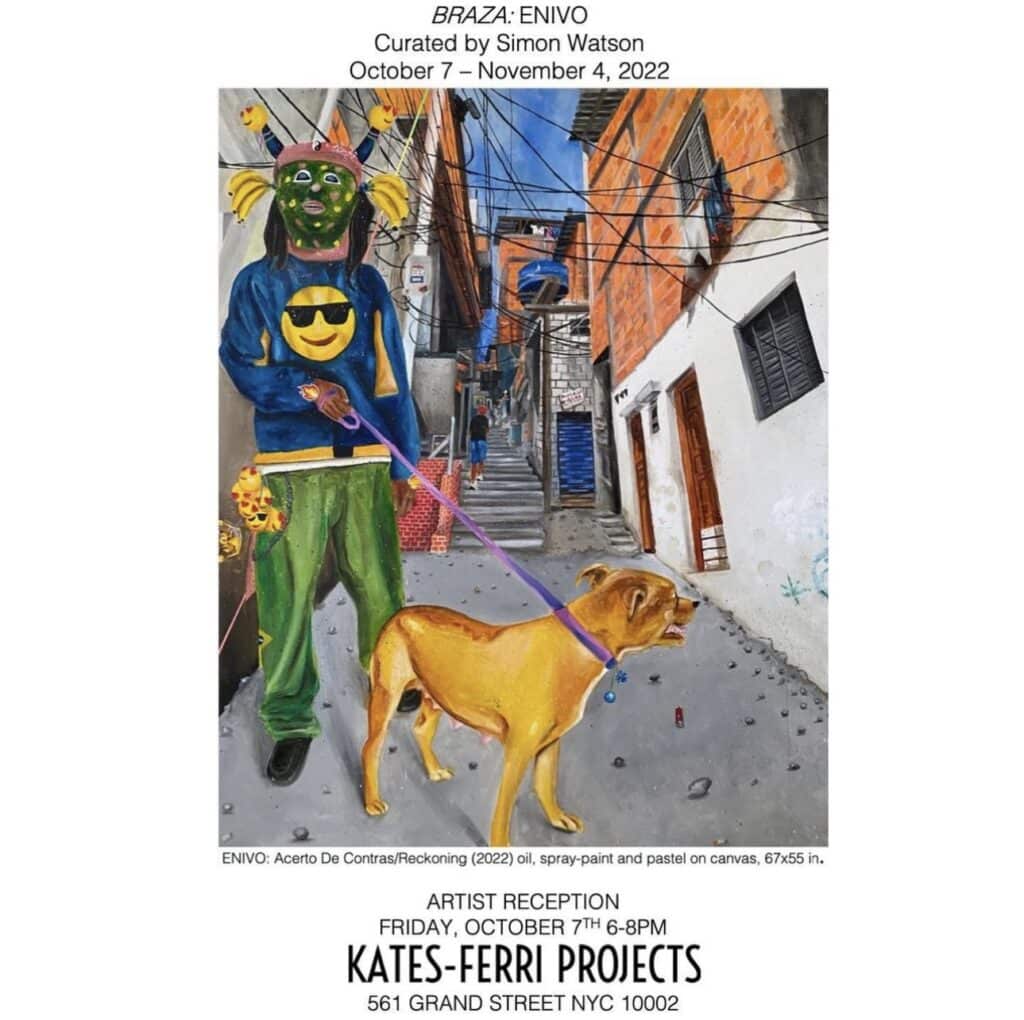

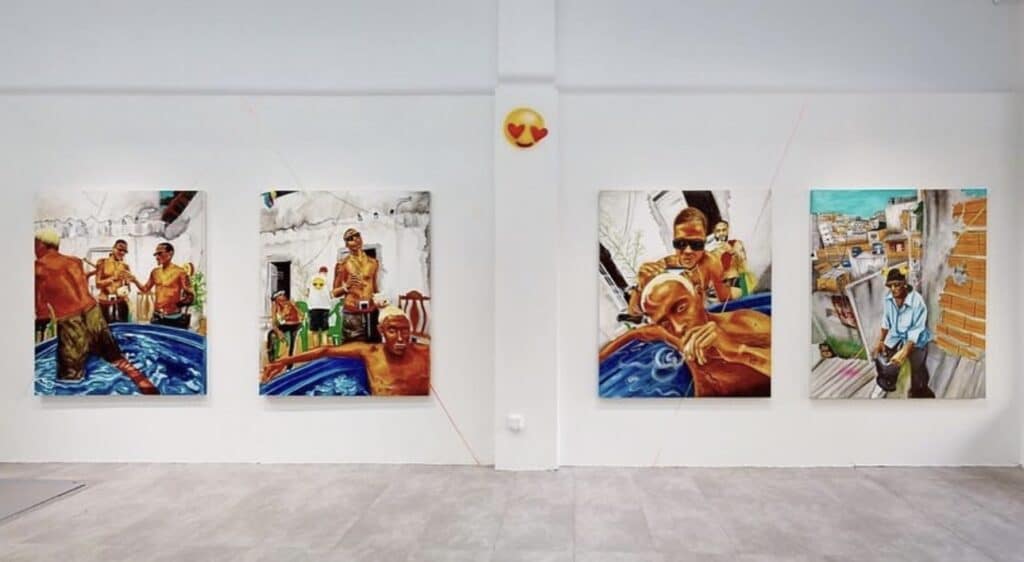
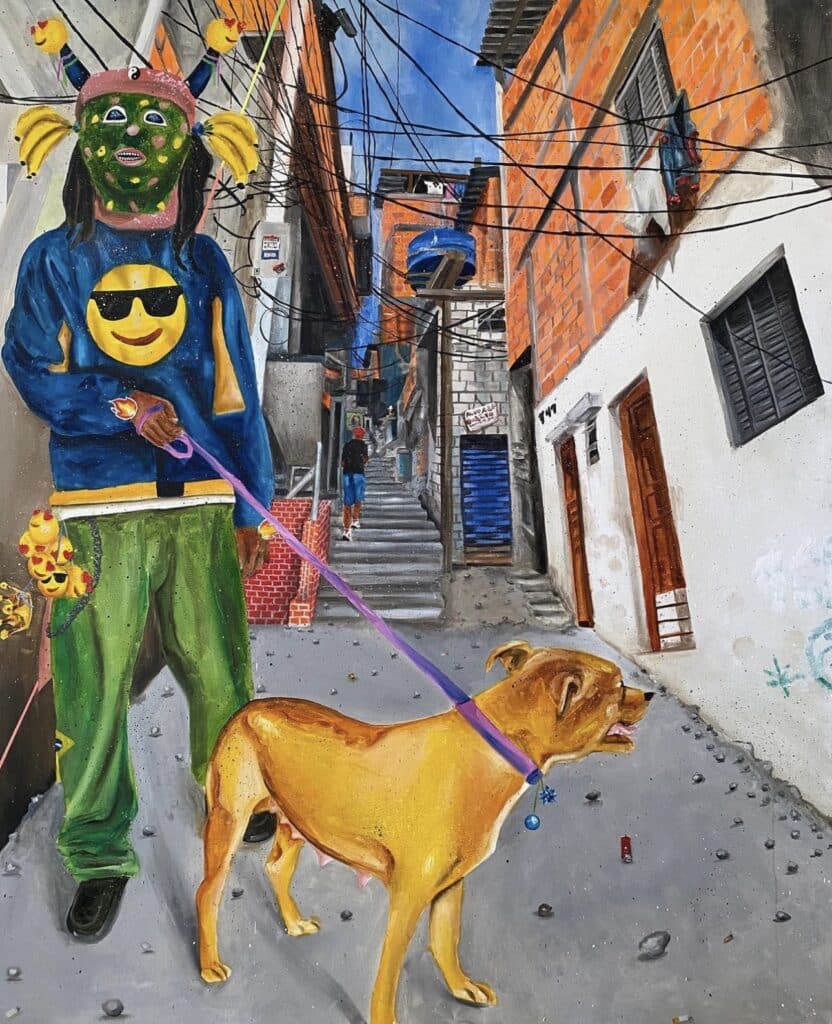
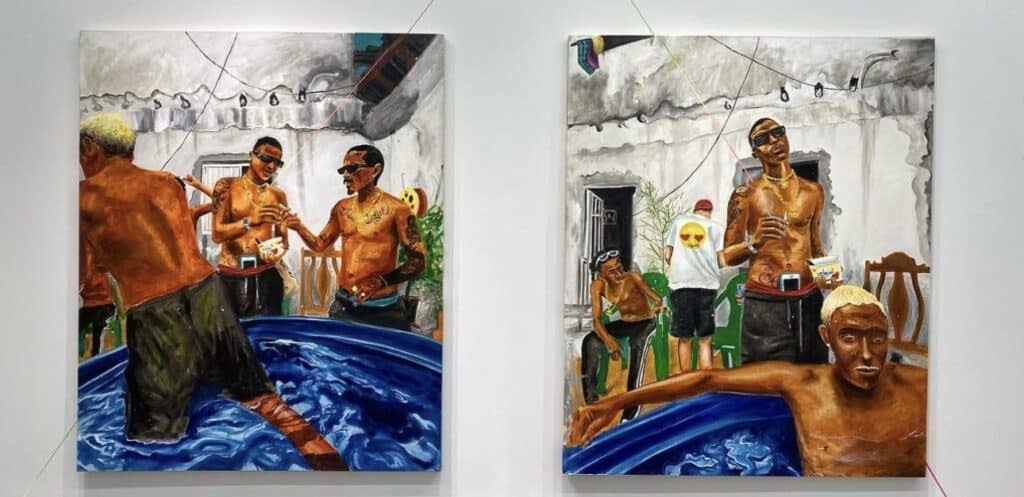
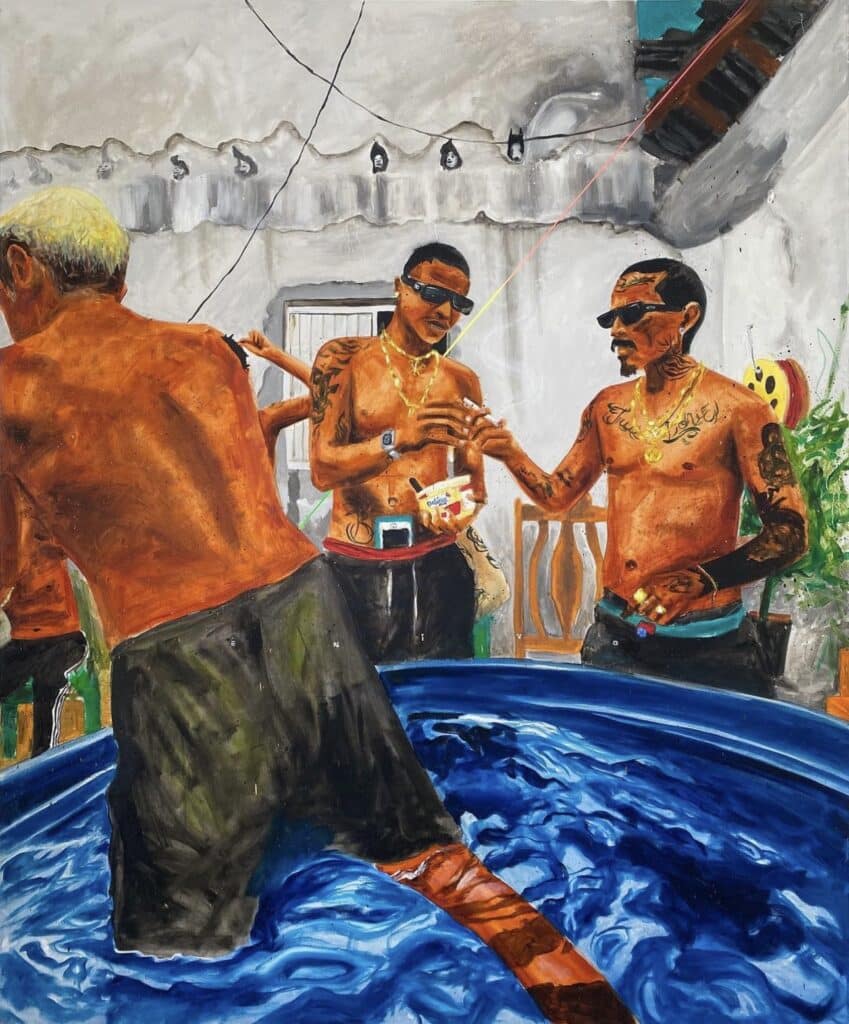
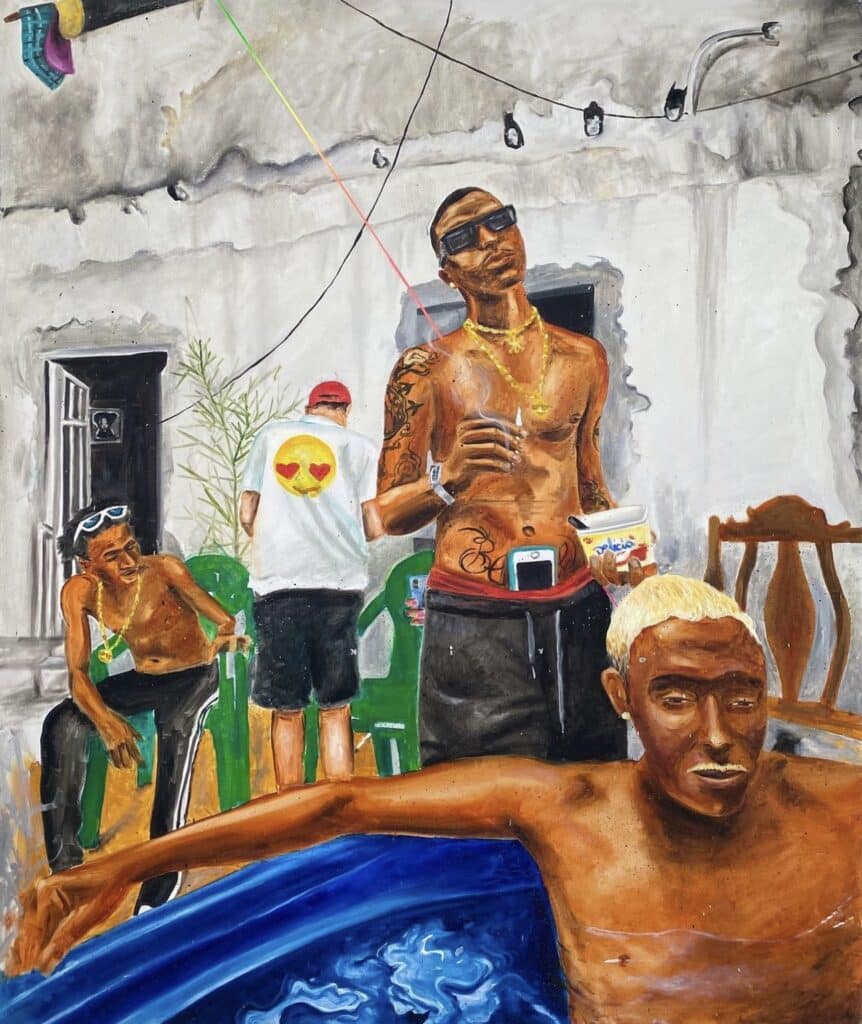
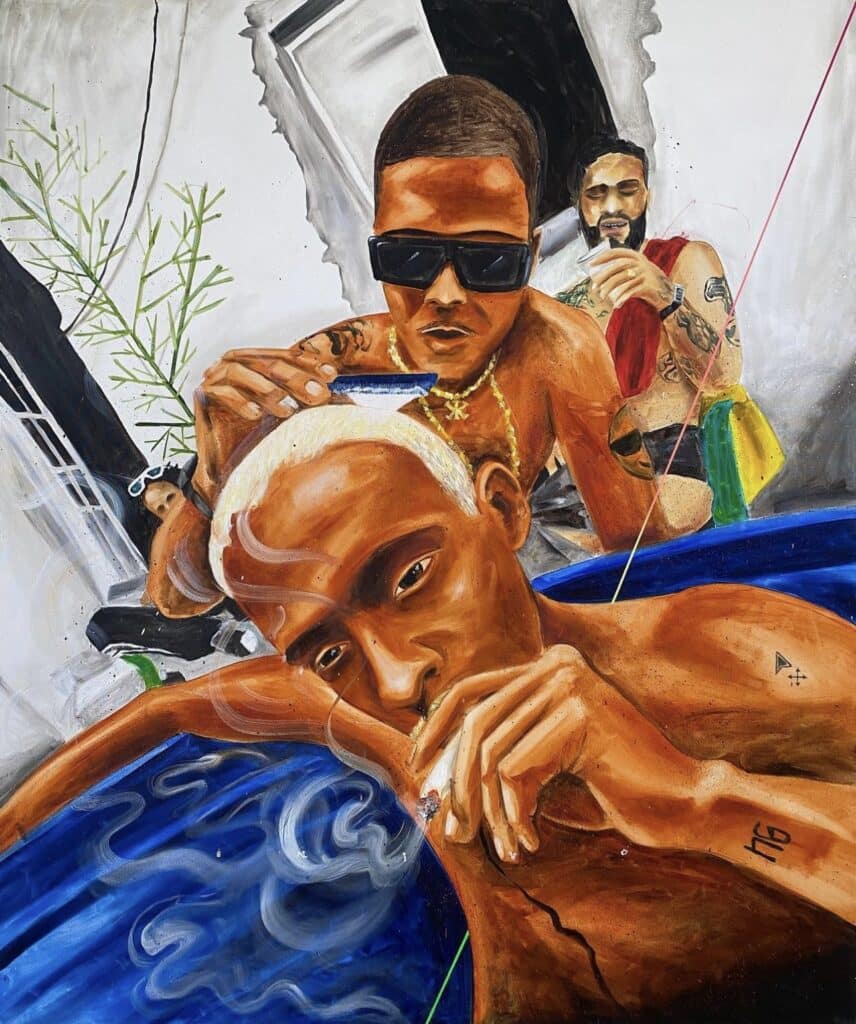

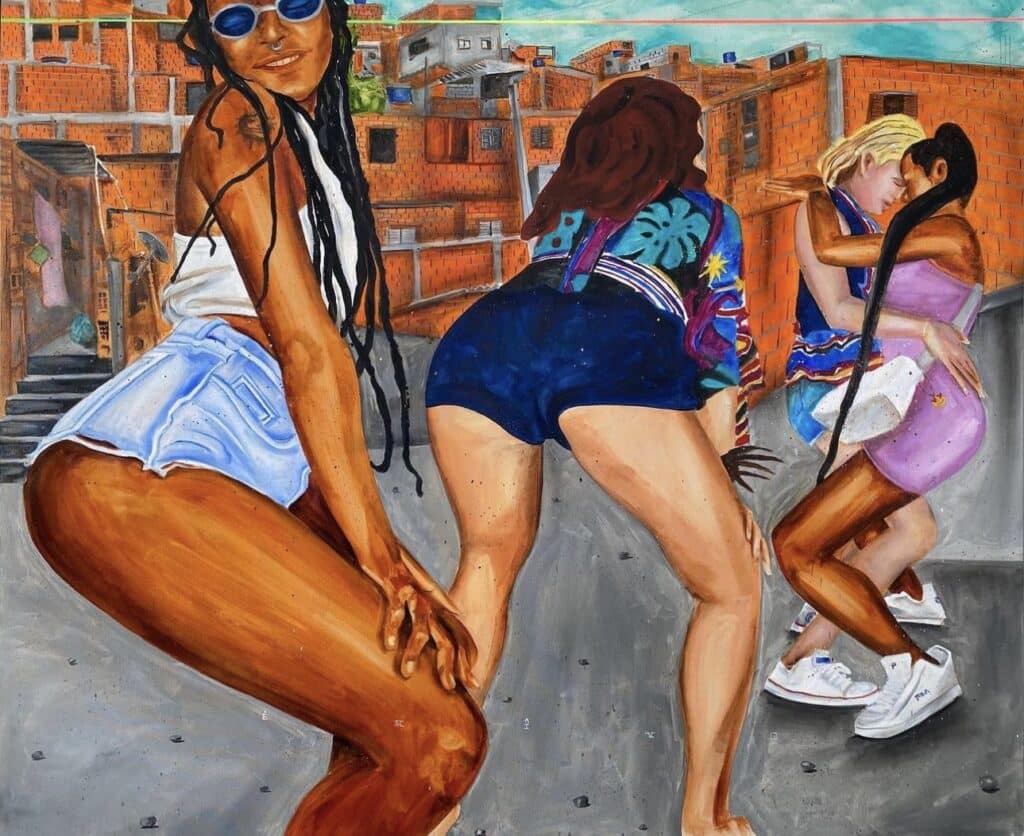
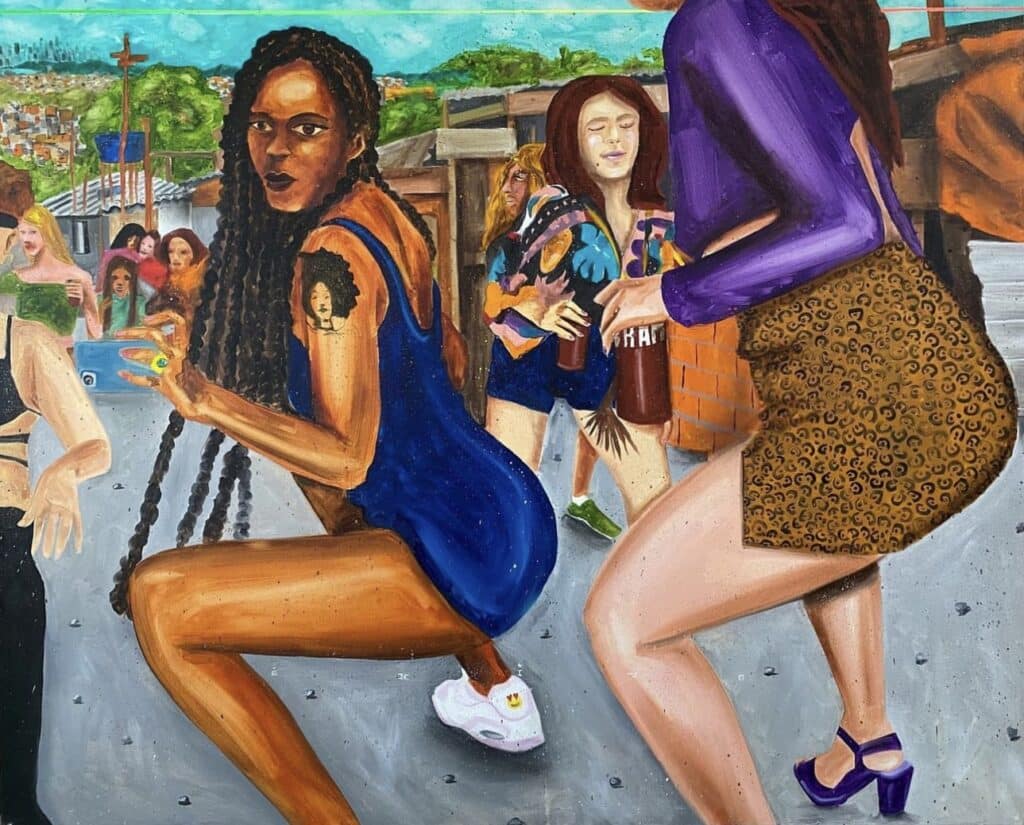
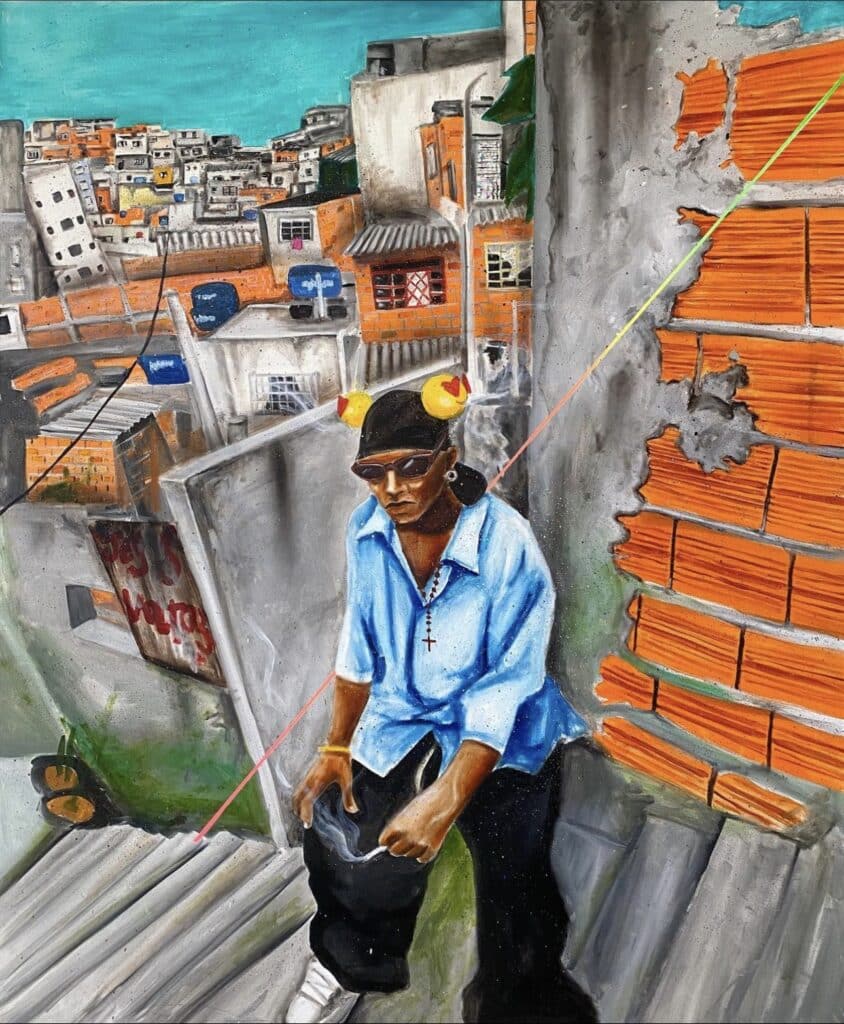
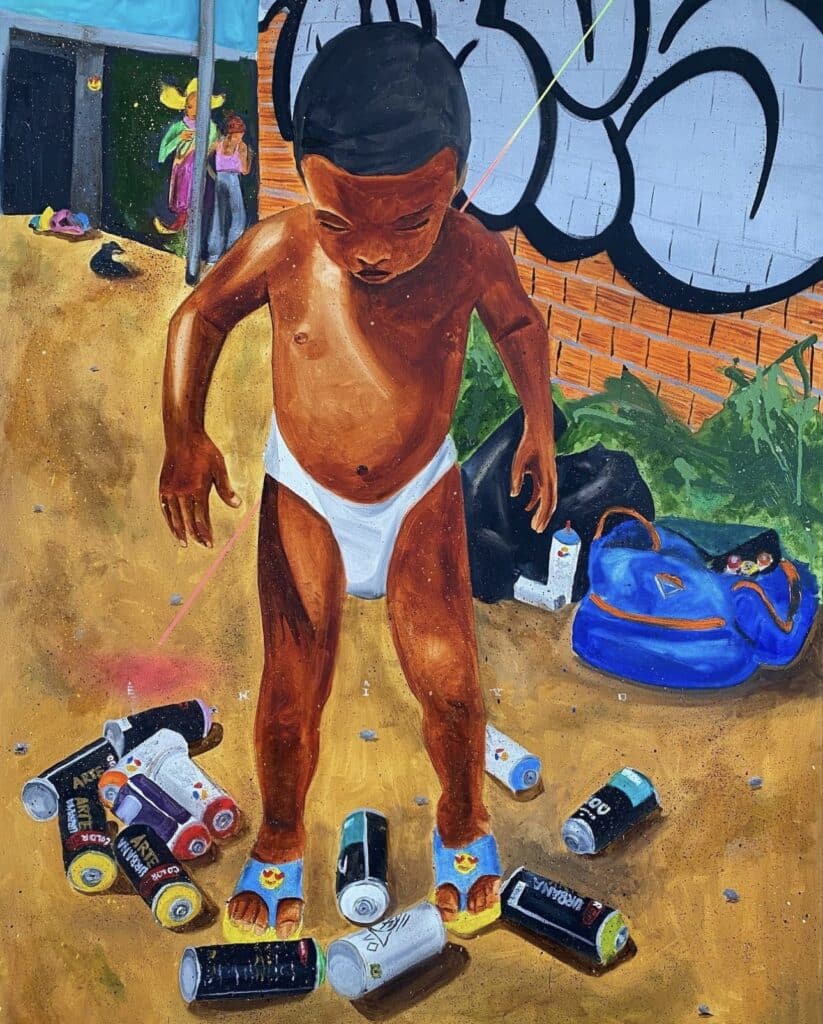
In 2022, ENIVO grew as both a man and an artist of the people – using his talent and creative mind to honor his origins, to bring his culture under the spotlight and to remind us that we are human after all and should embrace our own life and those of our neighbors.
CLOVIS CAMARGO presents a rich series of figurative paintings through his new exhibition at the Centro Cultural Correios in Sao Paulo from October 25th to November 25th.
No better way to define Clovis’s work than through the words of Oscar D’Ambrósio, Doctor in Education, Art & Cultural History, and renowned South American art critic:
“The pictures created by Clovis Camargo form a sort of panel of the society and highlight the soul of the portrayed. One of his merits has been in managing to balance each composition between its main protagonist and his surrounding environment”
This is exactly what characterizes Clovis Camargo, his ability to depict figures whose unusual large eyes invite the audience to an inner reflection, while connecting them fully to their scenery.
Sensitive, Clovis Camargo believes in the depth of the being and his capacity to transmit energies through his senses. One of them being the look – one’s eyes cannot lie as they own a complex language which reveals the truth. While one can lie using words, his eyes will betray him. While one can talk and pretend to hate, his eyes will reveal the love he is trying to hide. Indeed, when we look at each other, we connect – the same way the audience connects with his paintings.
In his way, Clovis Camargo speaks up our inner emotions – without using words!
Lobotex' new exhibition INSOLITO opened in May 2022 at A7MA Gallery in Sao Paulo, where the artist redirects us to what is unusual and abnormal through his paintings and sculptures.
Luís Alexandre Lobot‘s new exhibition redirects us to that which is unusual. When we see a monolith on the horizon or a wooden bench taken from its usual use, we are facing something in a state of disuse. When things jump out of their everyday function, they become mysterious again, operating outside the conventional rules.
It is in this aspect that we are pleased to see the results of the new Lobotian experiences in painting and sculpture, where his poetics, based around the reveries and ludic objects, was deepened.
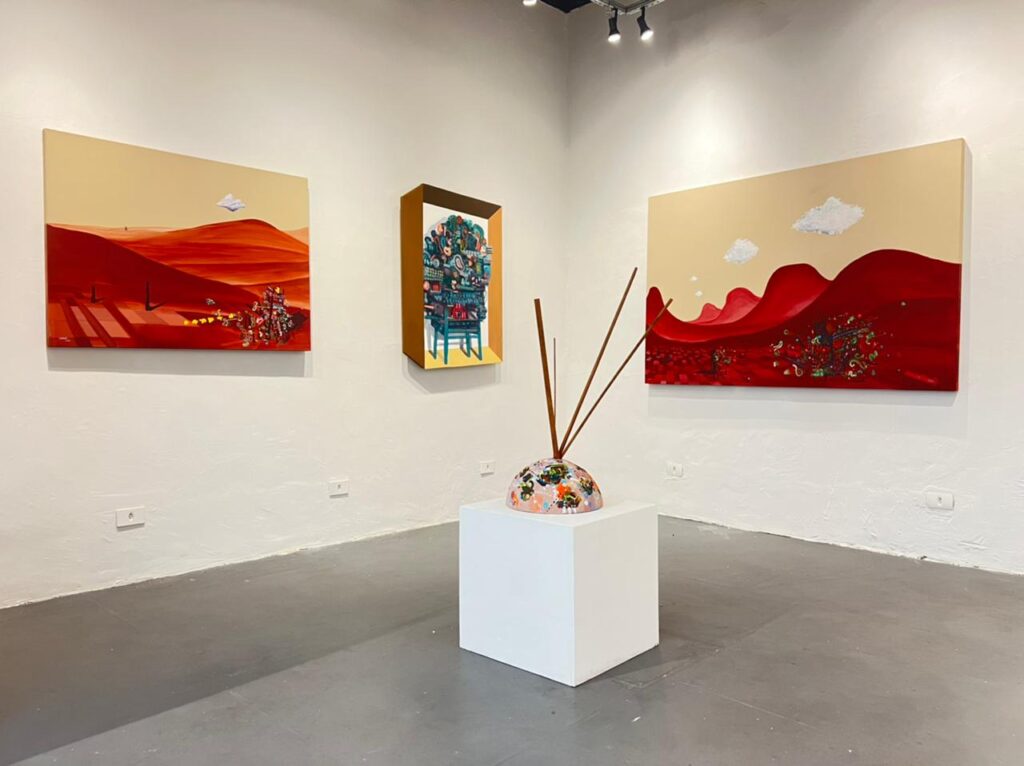
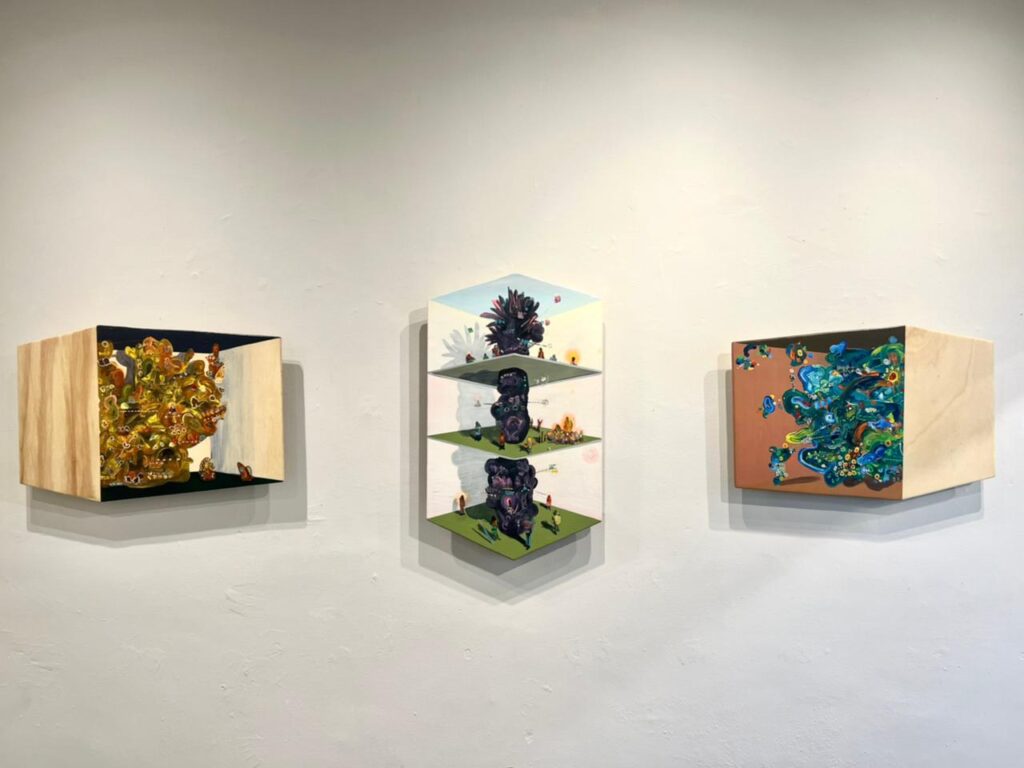
The nomadic landscapes of his canvases continue to undo the hierarchies of perception in a mystical strategy to bypass our spirit. This game requires a certain ludic maturity, for it takes us back to incipient times when a wooden stump could be anything. In other words, we verify if we still know how to daydream.
His private oratory is a kind of heresy, because only those with artistic maturity, worthly of a child of a Bishop of the Rosary, can generate something of his own substance and worship it. This shared defiance makes us lose our common senses and review our concepts of religious tradition.
That art with humour is more pleasing, we already know, but to invent something adorable goes beyond irony. The art here inverts perspectives and makes us stop seeing with the eyes of ideology, religion, family, and others. It suggests us that it is possible to strongly grasp what is ours and that we can be the starting point of things.
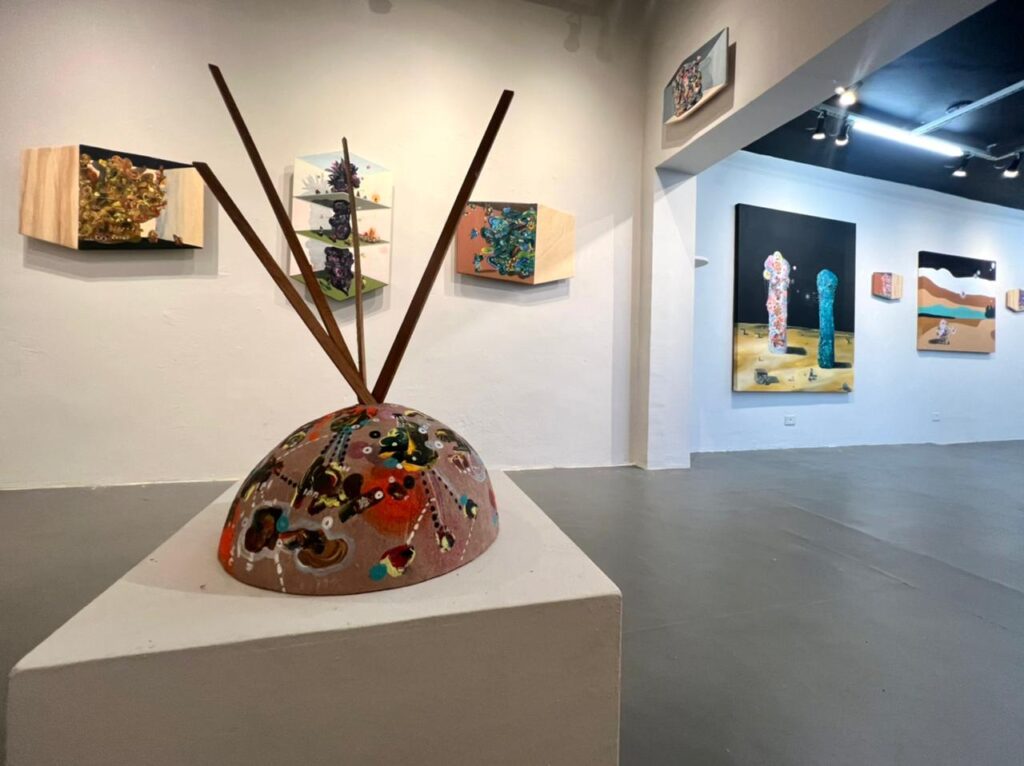
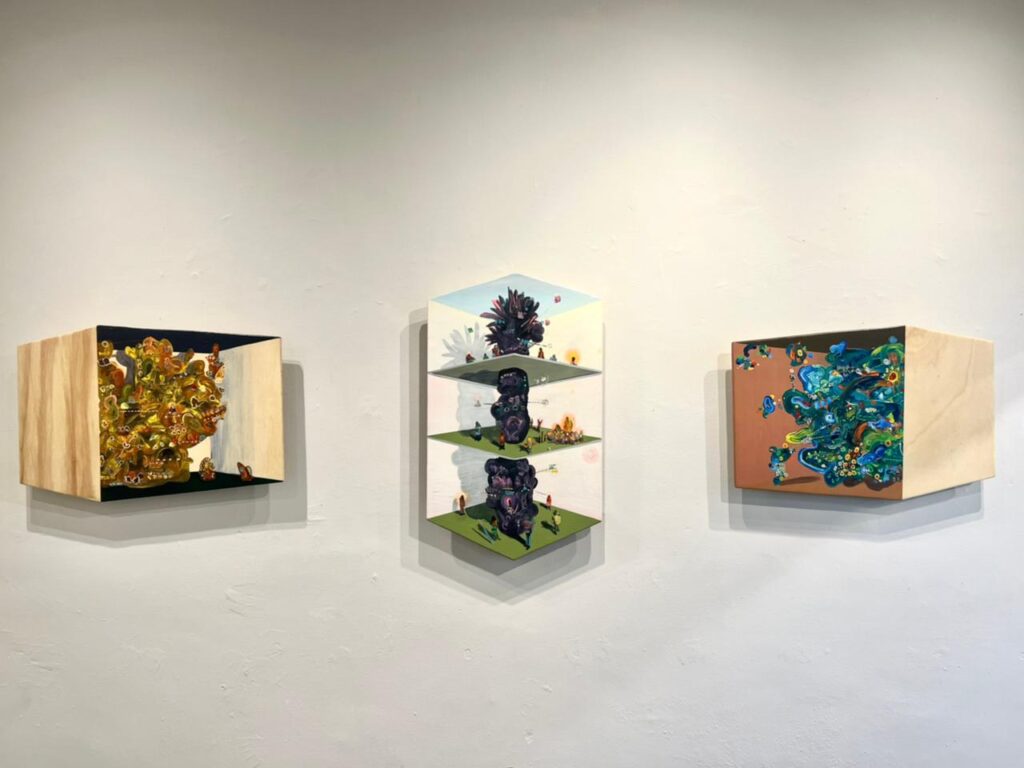
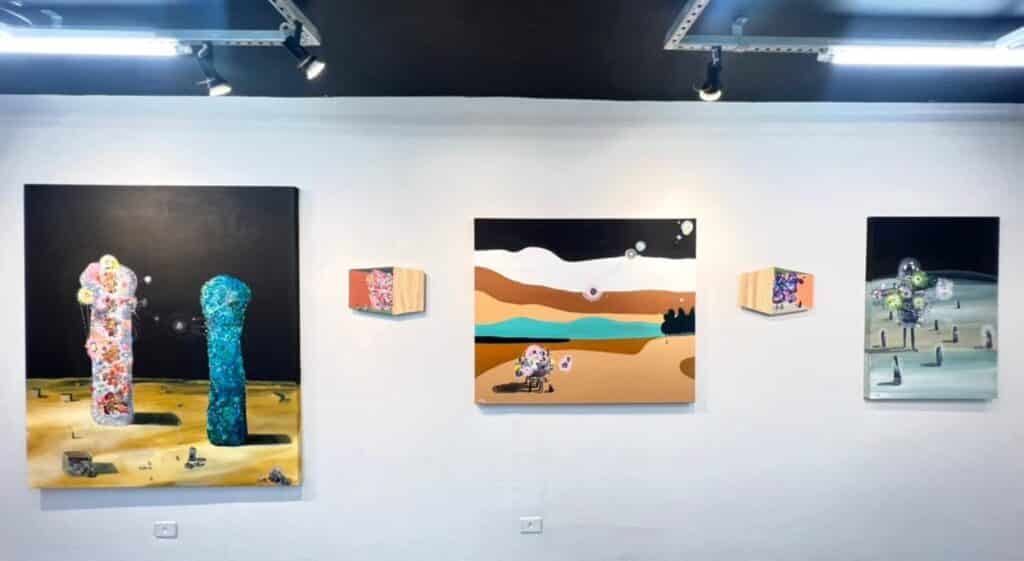
Lobotex performs his good old maneuver of providing contemplative states. Contemplation, nowadays, is something very difficult, but here there is an insistence in reminding us that poetry is visible and invisible, and that children play with it on the streets, while the ignorant people step on it every day.
His horses, priviously maquettes in glass cases, have gained a larger exhibition scale. Venturing into three dimensionalities, incorporating the space artist, Lobotex produced sculptures made of hardwood with tools that can bite off a finger, intending to enlarge them in the future towards the magnitude of public parks.
We are left here satisfied with this process, wondering what the size has to do with life. We feel, in INSOLITO, that once again some insignias of artistic intensity are transmitted to us, for as Rubens Espirito Santo says, the greatness of art comes from the incessant practice of making something – object, movement or speech – that takes us out of bed to start the day, that makes us turn off the fucking Netflix to do something worthwile with our live.
Text by Bruno Pastore, Guarulhos, May 2022